bellwether
INNOVATION IN ACTION
Penn Vet spearheads roboticsdriven technology to benefit animals and humans
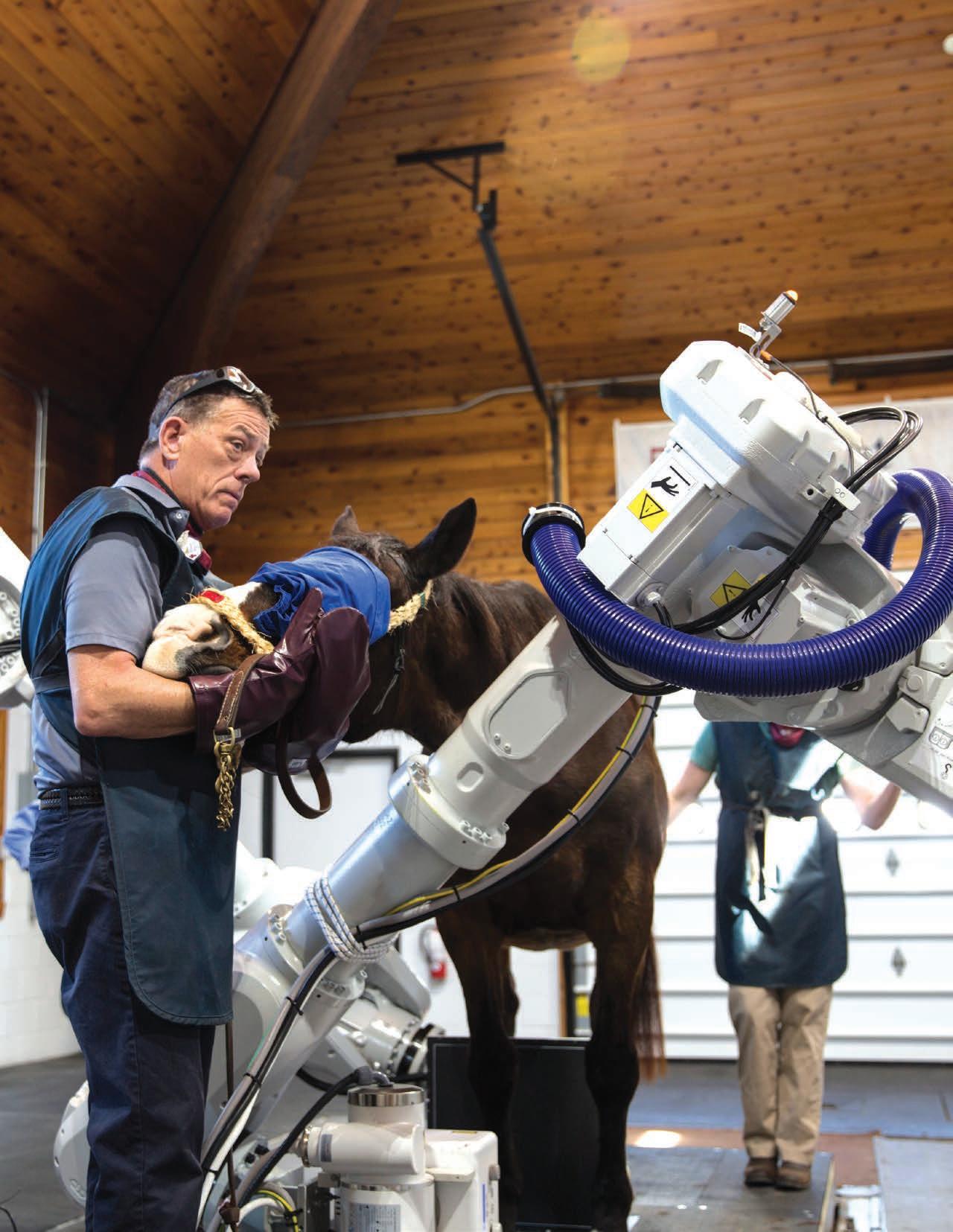
DEMYSTIFYING PET BEHAVIOR ALUMNI WHO LEAD IN ZOO, WILDLIFE, AND EXOTIC MEDICINE STUDENTS
GOING BOLDLY INTO THREE DIMENSIONS
WIN 2018 SAVMA BID
FALL 2016 #86
THE MAGAZINE OF PENN VET
From Aspiration to Innovation
Something must be wrong.
Dr. Barbara Dallap Schaer, Medical Director of New Bolton Center, wanted to schedule an emergency phone call. In my experience, an urgent need to talk to the Dean did not bode well. And when it turned out to be both Dr. Dallap Schaer and New Bolton Center’s Chief of Surgery Dr. Dean Richardson on the line, I almost had a panic attack.

How wrong I was. Drs. Dallap Schaer and Richardson had called to share their excitement about a robotics-driven equine imaging system they had been discussing with a company called Four Dimensional Digital Imaging (4DDI). They envisioned its broad and transformative potential, and their enthusiasm was infectious.
Less than two years later, the robots have arrived at New Bolton Center—poised to revolutionize animal and human health, and positioning Penn Vet at the forefront of a groundbreaking technology. We didn’t just buy this equipment. As the first veterinary teaching hospital in the world using the EQUIMAGINE™ system, Penn Vet is partnering with 4DDI to develop it and advance science in an unprecedented way.
I am exhilarated by the clinical, research, educational, and One Health possibilities of this new system. As a powerful teaching tool, I believe it may transform the way our students learn anatomy. And, we are already exploring translational applications that would tremendously benefit both adults and children. (See page 4 to learn more.)
Merriam-Webster defines “innovation” as “a new idea, device, or method” and “the act or process of introducing new ideas, devices, or methods.” The EQUIMAGINE™ system exemplifies innovation in action at Penn Vet. And it is one of many examples of tackling big challenges, forging boldly into new terrain, and introducing out-of-the-box solutions. At Penn Vet, no one ever says, “We don’t do that.” We say, “What if we could do that?”
In our quest to question, improve, and innovate, we often build bridges between disciplines. For instance, in an effort to enhance preparation and precision in veterinary neurosurgery, Dr. Evelyn Galban and her team turned to 3D printing—and established a partnership with PennDesign’s Fabrication Lab (read more on page 10). Like the robotic imaging, 3D printing offers us a new way to see and treat the complex structures of the body.
And, thanks to the generous support of Vernon and Shirley Hill, we are thrilled to launch an innovative and important cross-disciplinary initiative with the Wharton School: the Robert Marshak-Vernon Hill Scholarship Fund, which will support combined VMD-MBA training. There has never been a bigger need for veterinarians with strong business savvy, and for farmers to have veterinary partners to help them address animal, environmental, and economic issues (read more on page 20).
The scholarship fund honors Dr. Robert Marshak, Penn Vet’s ninth Dean, who embodies the School’s tradition of innovation. The Center for Animal Health and Productivity, established under his watch in 1986, continues to serve as an ally to the farming and agriculture industry. As Pennsylvania Department of Agriculture Secretary Russell Redding told Harrisburg’s The Patriot-News this spring, “I can’t imagine being in a state where you do not have access to a veterinary medical school and a campus such as New Bolton and being able to then protect the larger public and animal populations.”
The most recent winners of Penn Vet’s Student Inspiration Award—which was also initiated by the Hills—indicate that innovation continues to flourish here (see page 35 for details). As I think about these ambitious student projects, and about innovation at Penn Vet in general, I can’t help but recall a quote from Dr. Rose Nolen-Walston, Associate Professor of Large Animal Internal Medicine. “I love that you can smell the aspiration in the air!” she said during her interview to work at New Bolton Center. That aspiration—among our students, educators, clinicians, and staff—is what sparks innovation. And if we continue to boldly pursue new discoveries and catalyze new ideas, devices, and methods, we will continue to lead the way.
2 BELLWETHER FALL 2016 FROM THE DEAN
Joan C. Hendricks, V’79, GR’80
The Gilbert S. Kahn Dean of Veterinary Medicine
According to Penn President Amy Gutmann, “The pursuit of discovery is the very essence of the Penn experience.” Watch her yearin-review video featuring the EQUIMAGINE™ system at www.upenn.edu/ spotlights/yearpenn-2015-16
OFFICE OF ADVANCEMENT, ALUMNI RELATIONS, AND COMMUNICATIONS
Assistant Dean of Advancement, Alumni Relations, and Communications
Carol Pooser
Director of Alumni Relations
Kristen McMullen
Director of Communications
Ashley Berke
Director of Annual Giving and Advancement Services
Mary Berger
Director of Development for Companion Animals
Helen Radenkovic
Director of Development for New Bolton Center
Margaret Leardi
Director of Development and Board Relations
Jillian Marcussen
Web Communications Manager
Carole Cloud Communications Specialist for New Bolton Center
Louisa Shepard
Associate Director of Major Gifts
Neva Graham
Assistant Director of Institutional Events
Brittany Tinsley
Assistant Director of Annual Giving and Advancement Services
Barbara Belt
Communications Coordinator
John Donges
Advancement Services Coordinator
Sarah Trout
Administrative Assistant
Kathleen Murray
Financial Coordinator
Joan Cerceo
Editor
Karen Gross
Contributors
Sacha Adorno
Katherine Unger Baillie
Ashley Berke
John Donges
Karen Gross
Jillian Marcussen
Kristen McMullen
Steven Minicola
Louisa Shepard
Brittany Tinsley
Designer
Anne Marie Kane
Please address your correspondence to:
Ashley Berke
University of Pennsylvania
School of Veterinary Medicine
3800 Spruce Street Philadelphia, PA 19104-6010
(215) 898-1475
berke@vet.upenn.edu
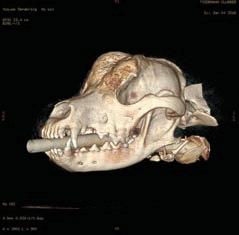


None of these articles is to be reproduced in any form without the permission of the School.
© Copyright 2016 by the Trustees of the University of Pennsylvania. The University of Pennsylvania values diversity and seeks talented students, faculty and staff from diverse backgrounds. The University of Pennsylvania does not discriminate on the basis of race, sex, sexual orientation, gender identity, religion, color, national or ethnic origin, age, disability, or status as a Vietnam Era Veteran or disabled veteran in the administration of educational policies, programs or activities; admissions policies; scholarship and loan awards; athletic, or other University administered programs or employment. Questions or complaints regarding this policy should be directed to: Executive Director, Office of Affirmative
departments 2 Dean’s Message 16 Events 18 New Overseers 19 Planned Giving Profile 20 Campus Updates 24 Faculty, Staff, & Student News 32 Graduation 2016 34 In Memoriam 45 Alumni News 48 Calendar WWW.VET.UPENN.EDU/BELLWETHER 3
Action and Equal Opportunity Programs, Sansom Place East, 3600 Chestnut Street, Suite 228, Philadelphia, PA 19104-6106 or by phone at (215) 898-6993 (Voice) or (215) 898-7803 (TDD). features 4 ROBOT REVOLUTION 10 GOING BOLDLY INTO THREE DIMENSIONS 13 ILLUMINATING THE MYSTERIES OF PET BEHAVIOR 37 PENN VET WINS SAVMA BID FOR 2018 ANNUAL CONVENTION 40 ALUMNI WHO LEAD IN ZOO, WILDLIFE, AND EXOTIC MEDICINE FALL 2016 #86 THE MAGAZINE OF PENN VET 10 4 about the cover Dr. Dean Richardson, Chief of Surgery at New Bolton Center, works with the new robotics-controlled system for use with the standing and moving horse. This bold innovation in imaging is part of Penn Vet’s One Health mission to advance animal and human health. Photo by Steven Minicola 13 bellwether contents BELLWETHER HAS BEEN DIGITIZED! You can now read Bellwether back issues dating to the magazine’s beginnings in 1981. Visit repository.upenn.edu/bellwether

4 BELLWETHER FALL 2016
REVOLUTION robot
BY LOUISA SHEPARD
Taking the lead to revolutionize equine imaging, Penn Vet’s New Bolton Center recently acquired a robotics-controlled system for use with the standing and moving horse.
Penn Vet is the first veterinary teaching hospital in the world using the EQUIMAGINE™ system, which has clinical and research applications for both animal and human medicine. In collaboration with Four Dimensional Digital Imaging (4DDI), the company behind the system’s innovation, New Bolton Center veterinarians are developing application-related protocols for large animals.
“The robots,” as the system is called on campus, were installed in February—a year and a week after New Bolton Center leaders first viewed the technology. The team is developing protocols for the horse, and optimizing and refining image quality. They anticipate full development will take until the spring of 2017.
“We thought, if it works, it could change the face of equine imaging,” said Dr. Barbara Dallap Schaer, Medical Director of New Bolton Center.
The system is capable of capturing the equine anatomy in a way never before possible: while the horse is awake, moving, and load-bearing. Existing computed tomography (CT) systems usually require the horse to be anesthetized and are limited to parts of the animal that fit into the opening in the cylindrical machines.
“The robots can easily move all around the horse in any orientation while the horse is standing, so we can see many parts of the anatomy we’ve never seen before,” Dallap Schaer said.
The system delivers the “holy grail” of imaging: a clear, complex, high-resolution image that tolerates patient motion, she said.
WWW.VET.UPENN.EDU/BELLWETHER 5
New Bolton Center’s new technology will benefit animals and humans
(Opposite page) The New Bolton Center clinical team collaborates to develop large animal protocols for the EQUIMAGINE™ system.
(From left) Dr. Chris Ryan, Radiologist; Dr. Dean Richardson, Chief of Surgery; and Dr. Barbara Dallap Schaer, Medical Director of New Bolton Center.
“We can see these things in more detail than ever before, and in ways not possible with traditional CT,” she continued.
This bold innovation in imaging is part of Penn Vet’s One Health mission to advance animal and human health, said Dean Joan Hendricks.

“There have been tremendous advances in health care throughout our long history, many of them at New Bolton Center. This new robotics system is a remarkable innovation,” Hendricks said at an April press conference to unveil the robots to the public.
“All of our hopes are moving along,” she continued. “We are excited about the potential for our large animal patients, especially horses. And, as we often see to be the case, these innovations may also help people.”
What Can the Robots Do?
The robotics-driven technology unites automation with powerful computer algorithms. ABB, a leading global manufacturer of industrial robots, supplies the robots and many of the control components used in the 4DDI systems. Pairs of robots move around the animal, programmed and directed by a technician in a control room. The approach will ultimately allow examination of the entire horse anatomy, with initial work focusing on areas with the greatest clinical need: the head, neck, and limbs.
The EQUIMAGINE™ system can collect typical, two-dimensional CT images; create three-dimensional images; produce 360-degree digital radiographic studies; and capture highspeed fluoroscopic images. It also can perform tomosynthesis, which produces extremely high-resolution images of a very small, focused area. Eventually, researchers, clinicians, and engineers hope to program the robots to capture images of a horse running on a treadmill.
The quality and resolution of the real-time images created with the EQUIMAGINE™ system far exceeds existing technology available for the standing horse. And the system also makes imaging much more efficient and effective. The three-dimensional scans take less than a minute, a fraction of the time it takes to produce multiple static images.
Most specialists at New Bolton Center will be able to take advantage of the roboticsdriven technology, including those in surgery, sports medicine, neurology, cardiovascular medicine, and internal medicine. “The possibilities are almost unlimited in terms of the conditions that can be addressed with this system,” Dallap Schaer said.
Preventing catastrophic injuries is one of these possibilities, as the experts look at distal limbs of the standing horse, said Dr. Dean Richardson, Chief of Surgery at New Bolton Center. He is providing surgical expertise for further refinement of the system—especially with respect to orthopedics.
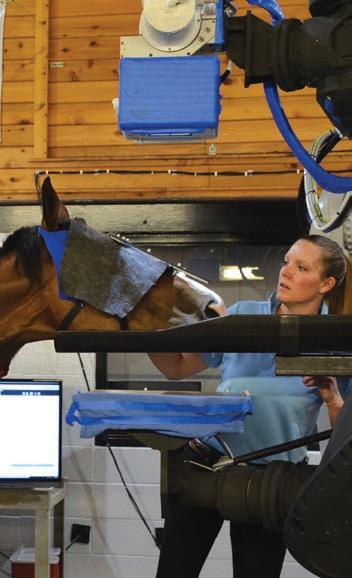
Richardson has vast experience using CT imaging during surgery to treat horses with serious fractures. The images from the new system are much more detailed, he said, and can help to identify not only a fracture, but also its specific characteristics: location, depth, and breadth. He expects the new technology will also help prevent injuries, especially in racehorses, by allowing early detection of fractures.
“Three-dimensional imaging provides the opportunity to be more precise in our treatments. That’s a big step forward,” Richardson explained. “The goal in veterinary and human medicine is to provide less invasive and more precise surgical procedures.”
“We feel very confident this technology has the potential to prevent catastrophic breakdowns at racetracks by identifying these pre-existing lesions much more easily,” he added.
New Bolton Center’s purchase of the system includes four robots: the two large units now installed in New Bolton Center’s treadmill building, and two smaller units to be installed near New Bolton Center’s orthopedic surgery suite later this year.
After months of installation, development, and testing, client-owned horses came for clinical trials in May. Specialists from 4DDI are working with New Bolton Center clinicians
6 BELLWETHER FALL 2016
a video of the EQUIMAGINE™ system in action at New Bolton Center! Visit www.vet. upenn.edu/equimagine
Watch
(Top) Kathryn Minacci, New Bolton Center imaging technician, preparing a patient for a CT of the skull.
(Bottom) New Bolton Center clinicians discuss the performance of the EQUIMAGINE™ system as they work to develop protocols for imaging large animals. (From left) Dr. Barbara Dallap Schaer, Medical Director of New Bolton Center; Dr. Chris Ryan, Radiologist; and Dr. Dean Richardson, Chief of Surgery.
during the first year to further the application capabilities of the system. And Penn Vet has rounded out its staff in conjunction with the new robotic technology.

Radiologist Dr. Chris Ryan, a Penn Vet alumnus who has a background not only in equine medicine but also in engineering, is a key member of the team, dedicated to interpreting the scans.
“My goal is to help bring this new robotic imaging modality from the research and development phase to everyday clinical use,” said Ryan, who joined the staff in 2015.
In addition, radiologist and Penn Vet alumna Dr. Kathryn Wulster joined New Bolton Center’s full-time faculty in August as an Assistant Professor of Diagnostic Imaging. While Wulster will provide expertise for many imaging modalities, her main clinical focus will be to advance MRI and robotic CT capabilities.
How Does It Work?
New Bolton Center’s new imaging system is located in a spacious, wood-paneled building constructed 25 years ago for the Jeffords high-speed treadmill, a revolutionary equine sports medicine technology at that time. Now, the robotic arms are bookends on either side of the treadmill, and the computer equipment and controls are in an adjacent enclosed, windowed room.
The horse is walked up a ramp and sedated. Communicating through a sophisticated human-machine interface (HMI), a technician directs the robots to the ready position near the horse, and then adjusts the two arms based on the anatomy of that particular patient. The robot arms are paired and move together, the emitter on one arm and detector on the other. The system requires only two people to operate, one to hold the horse and the other to manipulate the controls. The operator sets the pathway and the robotic arms move around the animal. The image acquisition takes about 30 seconds.
Carole Johnson, Director of Client Services and Imaging, and a radiology technician with 35 years of experience acquiring images of the horse, provides guidance and technical support. Under Johnson’s direction, imaging technician Kathryn Minacci has taken the lead on operating the robots and reconstructing the images.
The EQUIMAGINE™ process is significantly less invasive, less risky, and less expensive than using general anesthesia. While general anesthesia is routinely used for imaging and medical procedures, there are always risks when a horse wakes and stands up, so it is avoided when possible.

“The process of awaking from general anesthesia is an athletic event for the horse,” Dallap Schaer said. “Eliminating the need for anesthesia is a significant advantage for us.”
Human-Animal Connection
The system will be important not only for clinical use in the hospital, but also for research, teaching, and translational opportunities.
“This technology enables us to push the ‘One Health’ research frontiers in imaging to better understand potential new pathologies that haven’t been detected before,” said Dr. Thomas Schaer, Director of Penn Vet’s Preclinical Service Core & Translation in Orthopedic Surgery, who is leading the translational research efforts.
The robotics-driven imaging will be used to support many initiatives to help the horse, including treatment of horses with neurologic disease, and racehorse and performance horse safety. As Schaer explained, “We will image the lower limb of the horse on the treadmill to look for clues in joints while in motion. These dynamic studies may help us better understand patterns that could explain why joint degeneration occurs.”
With many specialists engaged in research, Penn Vet experts are also working with colleagues at Penn Medicine—as well as the Rothman Institute and Nemours Children’s Health System—to identify and develop applications in human medicine.
WWW.VET.UPENN.EDU/BELLWETHER 7
(Top) A three-dimensional reconstruction of an equine carpus (knee) from CT scan data generated by the imaging system.
(Bottom) A CT scan of a foal neck with atlanto-axial joint sepsis and associated osteomyelitis of the axis (C2).
“Being able to image a veterinary or human patient in motion can be a game changer. For example, evaluating joints or the spine when they move will allow us to expand our knowledge to better understand certain clinical symptoms.”
Dr.
“Whether you are a bipedal human or a quadruped, you are going to benefit from this,” said Schaer. “It is incredibly exciting.”
Penn Medicine’s Dr. Neil Malhotra is Vice Chairman for Operations and Associate Program Director of the Department of Neurological Surgery at the Hospital of the University of Pennsylvania. He is also Co-Director of the Translational Spine Research Lab, and has been collaborating with Schaer for the past 10 years.
In his work as a neurosurgeon, Malhotra treats and studies the brain, the spinal column, and the spinal cord. The robotic technology, he said, “gets us one step closer to understanding pain” because clinicians can see joints and the spine in natural motion.
“There is the potential opportunity to understand both disease and treatments of disease,” Malhotra said. “We are already talking about projects we can do immediately involving motion.”
The ability to obtain high-quality images of a human joint in motion, or the spine, or the head, could open up vast possibilities of discovery in the areas of diagnosis, treatment, and medical product development. The technology could be used in many human medicine specialties, Schaer said. Excellent imaging capabilities such as MRI and CT exist, but they are static. Dynamic imaging can add an entire new dimension.
“The system is going to allow us to explore tissues in a dynamic setting, in motion. Being able to image a veterinary or human patient in motion can be a game changer,” Schaer said. “For example, evaluating joints or the spine when they move will allow us to expand our knowledge to better understand certain clinical symptoms.”
In pediatric patients, having the ability to compensate for accidental motion in imaging could be a “game changer” for children and infants who are too compromised or too sick for sedation or general anesthesia. The robotics-controlled system would allow imaging of a child while awake and moving, talking with their parents, even playing a game on their phones while the images are taken in less than a minute.
Additionally, robotics-controlled imaging has the potential to improve intra-operative imaging and workflows, Schaer said. Operating suites equipped with imaging robots with no constraints to a gantry will allow for quick and precise imaging studies of virtually any part of the patient’s body on demand.
Clinical, Research, and Educational Innovation
The acquisition of the EQUIMAGINE™ system was funded in part by a generous gift from the estate of Mimi Thorington. Additional gifts will help to integrate the new technology into the clinical and research programs at New Bolton Center.
As the experts at New Bolton Center work with the new system and better understand its full potential, these discoveries can then be translated to clinical use. “These are hypothesisdriven research applications that ultimately will funnel into improved clinical care,” Schaer said.
For research purposes, one goal is to first understand “normal” and then “abnormal” in imaging at a greater resolution. “We now have another tool that allows us to image our patients in areas we’ve never been able to image, or image well, and there is a lot to learn,” he said.
There are great possibilities for teaching, as well. “Three-dimensional imaging is an enormously valuable tool in teaching anatomy, and there is nothing more important in the education of a medical specialist than understanding anatomy,” Richardson noted.
The long-range plan is to incorporate the imaging system into a new surgical translational research center.
“New Bolton Center has a history of advancing equine surgery and medicine,” Richardson said. “This system is just one more tool that will prove New Bolton Center is on the forefront of veterinary medicine.”
8 BELLWETHER FALL 2016
Thomas Schaer
A LEAP OF FAITH, A NEW FRONTIER
Why did Four Dimensional Digital Imaging (4DDI) choose New Bolton Center as the beta site for the EQUIMAGINE™ system?
The veterinary experts at Penn Vet are willing to collaborate to develop the protocols for use with large animals, noted Nicholas Hunt, Chief Technology Officer for 4DDI, who has led the team doing the installation.
“The caliber of the individuals I’m working with here at New Bolton Center is truly humbling. It’s clear to me why they are viewed as industry leaders in the field of veterinary medicine,” Hunt said. “The attention to process quality and safety of the operators, as well as the animals, is remarkable.”
The horse is probably “the most sophisticated and difficult patient we will ever encounter,” because of the size and complexity of the animal, as well as the need to correct for motion, said Yiorgos Papaioannou, 4DDI Chief Executive Officer.
“If we are able to tackle and solve the challenges with the horse, the technology could be easily transferred to other domains of imaging, in humans, or small animals,” he said. “It’s a great opportunity for us to validate our work with renowned academics, surgeons, radiologists, and radiographic technicians.”
The collaboration with 4DDI also offered significant advantages for New Bolton Center. A large-bore CT had been tested in the fall of 2014, but it didn’t meet the many needs of the hospital and its specialists. The robotic technology offered so many more possibilities.
In addition, attracting a full-time, large animal radiologist—a rare commodity—was impossible without a critical mass of the latest equipment and technologies, said Dallap Schaer, who took the reins of the New Bolton Center hospital in 2014.
Forging into this unknown territory has been a leap of faith, she said. “At some point you have to just take that leap. We determined that, if it could work, we would be 20 years ahead. It might be a really big push, and it might be a big risk, but the gain would be tremendous.”
The New Bolton Center team did its due diligence, going through a series of steps before signing the purchase contract. Dallap Schaer and Richardson visited the robot plant in Michigan to learn how the technology worked, then scanned cadaver limbs, then scanned a live horse, and evaluated the results.
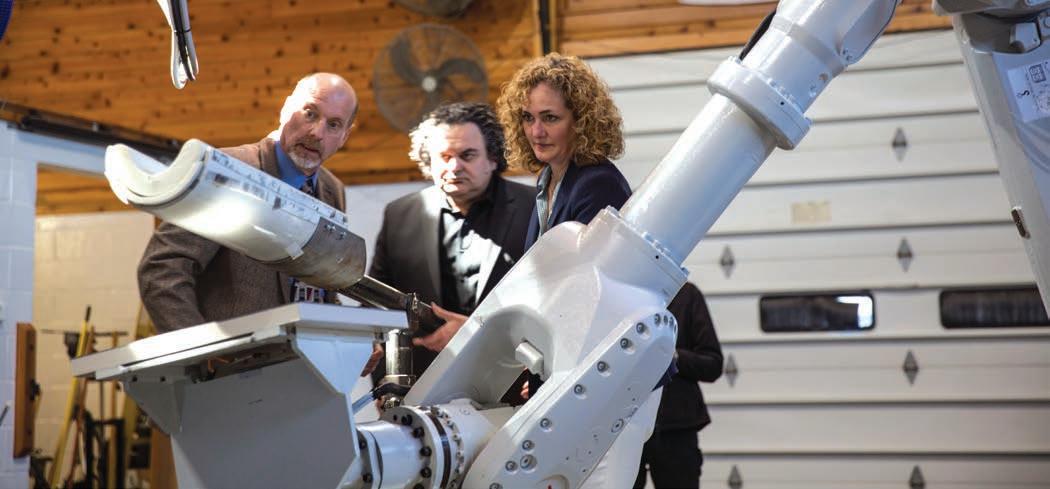
“We feel strongly that if someone is going to develop such a system it should be at a veterinary teaching hospital,” Dallap Schaer said. “It should be done rigorously and with the mindful input of many.”
Every day, working with the robots brings a new advance, a new discovery.
“We have a lot to learn about this technology,” Richardson said. “Three-dimensional imaging opens new doors to diagnosis and treatments. We are very excited to be on the forefront of those discoveries.”
As Dallap Schaer emphasized, “We are trying to bring together all of our strengths at Penn Vet to be truly transformational.”
WWW.VET.UPENN.EDU/BELLWETHER 9
(From left) Nicholas Hunt and Yiorgos Papaioannou of Four Dimensional Digital Imaging (4DDI) with Penn Vet’s Dr. Barbara Dallap Schaer, Medical Director of New Bolton Center.
PENN VET GOES BOLDLY INTO THREE DIMENSIONS
BY SACHA ADORNO
EVER THE PIONEER, PENN VET IS VENTURING INTO NEW FRONTIERS, EXPLORING DIMENSIONS OF MEDICINE ONCE ONLY IMAGINED. LED BY ITS NEUROLOGY AND NEUROSURGERY SERVICE, THIS FORAY INTO THE FUTURE BEGAN A FEW YEARS AGO, WHEN DR. EVELYN GALBAN, CLINICAL ASSISTANT PROFESSOR OF NEUROLOGY AND NEUROSURGERY, TURNED TO 3D PRINTING FOR HELP IN A COMPLEX CASE.
AN INNOVATIVE EFFORT
At the time, Galban and her team were assessing Millie, an eight-month-old canine patient with a large mass on her skull. “We were looking at Millie’s CT scans and trying to clearly understand what surgery would involve—what areas would be affected and how serious it would be,” said Galban. “These questions are hard to answer with two dimensional images. So we started thinking about solutions that would let us hold Millie’s skull and look at it from all angles. That’s when we came up with the idea of printing a 3D replica of the skull, mass and all.”
Neurology resident Dr. Jonathan Wood researched the availability of 3D printers across the University, finding one in PennDesign’s Fabrication Lab. Galban contacted the lab for what would be the beginning of a successful inter-University
collaboration to help animal patients—and to transform veterinary neurology and neurosurgery.
Working with Millie’s CT scans, the Fabrication Lab printed a perfectly precise model of her skull, made from a gypsum powder that’s bound by acrylic and sealed with a cyanoacrylate, an industrial-grade adhesive. Having this clone enabled Galban, Wood, and the rest of Millie’s veterinary team to gain a deeper understanding of the mass’ placement and to practice their surgical approach before the pup’s operation.
Ultimately, Millie did not end up on Penn Vet’s operating table. But Galban and her team were hooked on 3D printing. In partnership with the Fabrication Lab, they have used the technology to replicate injuries and disease in other animals, including a cat and a goat. And, earlier this year, they successfully completed a complicated
10 BELLWETHER FALL 2016
procedure on a dog that likely would not have been possible without a 3D model.
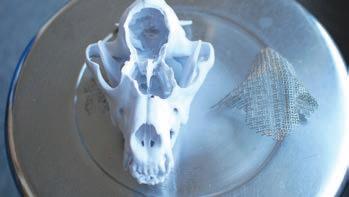


(See page 12 to read about Clubber’s case.)
Eager to create a collaborative global forum where veterinarians and students can share 3D models of real cases, Galban teamed up with the National Institutes of Health’s 3D Print Exchange—a webbased portal of printable models related to biomedical science. Over time, she aims to build Penn Vet’s collection on the Print Exchange into the world’s largest library of 3D animal models for veterinary practitioners everywhere to print, study, discuss, and consult.
SMART NEURO
Although Penn Vet’s bold journey into multi-dimensional medicine is in its earliest stages, Galban has big plans for applying 3D technologies to neurology and neurosurgery. She is calling the School’s 3D medicine program SMART Neuro—simulate, model, animate, reconstruct, transform. Currently, SMART Neuro offers the 3D Print Exchange library and 3D printing. Looking forward, Galban envisions it will one day include virtual reality and holography, both of which permit interactive simulations of individual surgeries with room for trial and error that’s not available on live patients.
Explained Galban, “I’m extremely interested in how virtual reality tools can give students deeper insight into real surgical
cases and faculty dynamic methods of educating and engaging tactile learners.”
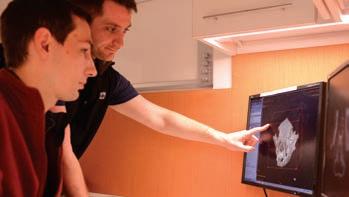
Pushing SMART Neuro’s boundaries even further is the ultimate in futuristic medicine: holography. At a recent conference, Galban had the opportunity to interact with a holographic heart.
“The hologram projected from a tablet in three dimensions,” she said. “Wearing special glasses and holding a special pen, I was able to rotate the heart in any direction, make it beat, add blood to it, and dissect it. I am excited to explore bringing holography to the School.”
Even though a fully realized SMART Neuro program still remains on the horizon for Penn Vet—more research is needed to identify what it would take to acquire the necessary equipment—Galban believes 3D medicine holds limitless possibilities for teaching, learning, and research.
“These innovations can really open up what we, as surgeons, educators, and researchers, are able to do,” she said. “They will not only make us more confident going into risky procedures, but will help everyone involved, from families to students to clinical staff, understand what’s going to happen before we even start working on the patient. The implications for education and advancing quality of care are truly boundary-breaking. And research applications for 3D medicine are limited only by the questions asked.”
“These innovations can really open up what we, as surgeons, educators, and researchers, are able to do. They will not only make us more confident going into risky procedures, but will help everyone involved, from families to students to clinical staff, understand what’s going to happen before we even start working on the patient.”
Dr. Evelyn Galban
WWW.VET.UPENN.EDU/BELLWETHER 11
IN CLUBBER’S CASE, “A WORLD OF DIFFERENCE”
Seven-year-old Clubber came to Penn Vet in late 2015 for treatment of a fibro-osseous proliferation between his eyes that extended to his brain. Penn Vet advised surgery, and the dog’s owners opted in.

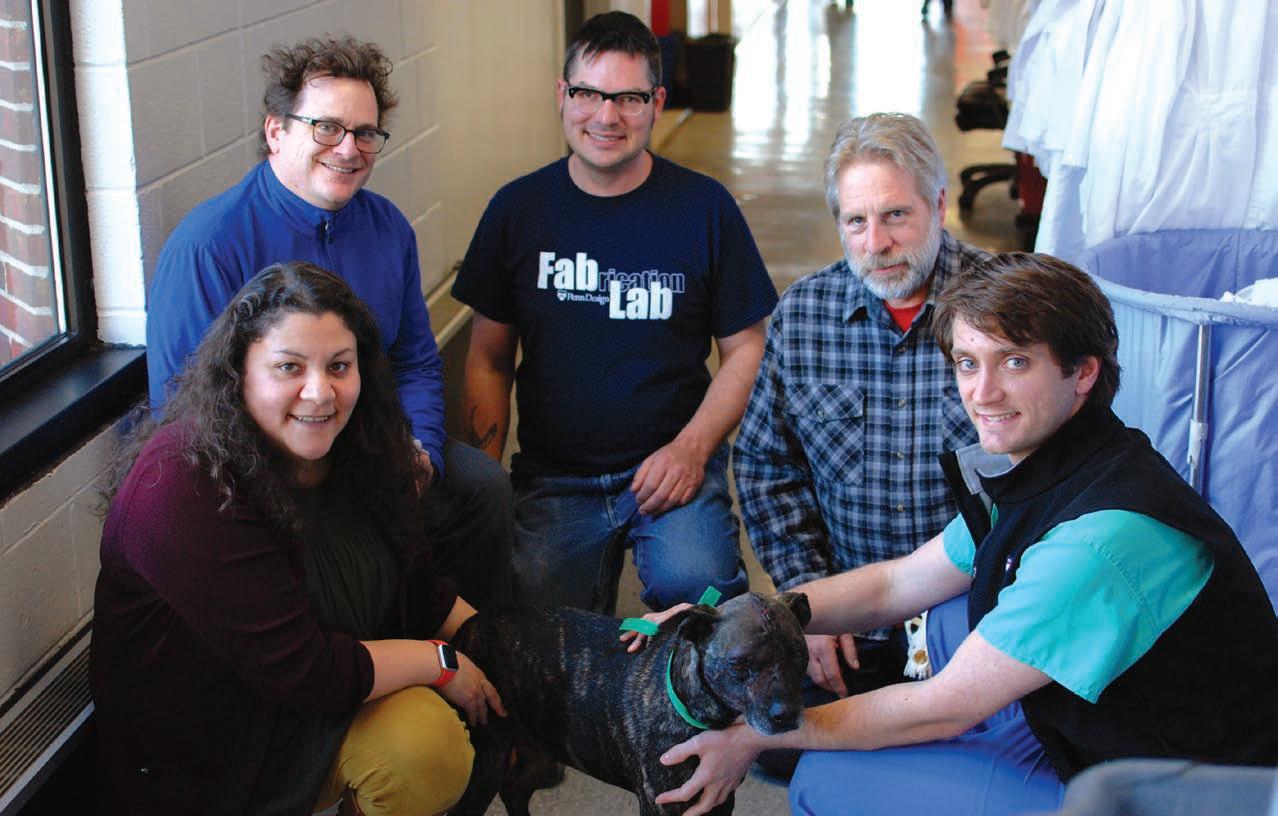
It was a risky and complicated procedure that would require removing a large portion of the skull. So Penn Vet called in a new partner to help in the case—PennDesign’s Fabrication Lab. Using files provided by Penn Vet, the lab printed a 3D model of Clubber’s diseased skull. Ahead of Clubber’s surgery, resident Jonathan Wood carved into the bone-like replica, creating an operating road map. Wood also used the model to mold a titanium mesh panel to replace the excised portion of the dog’s skull and protect his brain.
On operating day in January, Clubber’s surgical team removed a piece of his cranium, frontal sinus, and the orbits, referencing the 3D model for intra-operative guidance. “Having the model made a world of difference for us,” said Wood. “If we didn’t have the option to practice on the skull, I probably would not have recommended such an extensive surgery.”
After a seamless recovery, today Clubber is his regular self— happy, healthy, and eager to play. He recently visited the Fabrication Lab staff. Said Stephen Smeltzer, PennDesign’s Digital Fabrications Manager, “Working on Clubber’s case was unique for us. Our work isn’t usually applied in such immediate, life-saving situations. We are proud to have played a part in giving Clubber a new lease on life.”
12 BELLWETHER FALL 2016
Clubber’s treatment involved a collaborative effort between Penn Vet and PennDesign’s Fabrication Lab, which created a 3D model of Clubber’s skull prior to surgery. Pictured above with Clubber, from left, are Dr. Evelyn Galban, Clinical Assistant Professor of Neurology and Neurosurgery at Penn Vet; Fab Lab’s Stephen Smeltzer, Michael Stifel, and Dennis Pierattini; and Penn Vet neurology resident Dr. Jonathan Wood.
ILLUMINATING THE MYSTERIES OF PET BEHAVIOR INNOVATIVE
TOOLS HELP MAKE ACCURATE INFORMATION
ACCESSIBLE
BY KATHERINE UNGER BAILLIE
Many pet owners may find the behavior of their dogs and cats something of a mystery. Why does their dog bark at shadows on the wall? Why does their cat insist on sitting on the newspaper during breakfast? The desire to understand such seeming oddities becomes more urgent when the behaviors are dangerous or troublesome, such as when a dog begins acting aggressively to visitors or a cat stops using the litter box.
Researchers and clinicians at Penn Vet have been working for decades to help pet owners interpret and, in some cases, modify their animals’ behaviors. Now,

innovative initiatives from the Behavior Medicine Service and the Center for the Interaction of Animals and Society are furthering that understanding. The new Fe-BARQ behavioral questionnaire for cats, the previously developed C-BARQ for dogs, and a soon-to-be-piloted web portal for behavior medicine education and consultation are all aimed at bettering the lives of pets and their owners alike.
Back in 2003, Dr. James Serpell, Director of Penn Vet’s Center for the Interaction of Animals and Society, wanted to gather data about dog behavior for use in his research.
Find the C-BARQ and Fe-BARQ online at:
• http://vetapps.vet. upenn.edu/cbarq/
• http://vetapps.vet. upenn.edu/febarq/
WWW.VET.UPENN.EDU/BELLWETHER 13
RESEARCH BRIEF
“
“With dogs, it’s very clear what kind of behaviors are positive and what behaviors are negative. With cats, it’s not as clear.”
DR. JAMES SERPELL Director of Penn Vet’s Center for the Interaction of Animals and Society
Since it wasn’t practical to go into hundreds of homes to observe how dogs behaved, he decided to do the next best thing: ask the owners.
The result was C-BARQ, short for Canine Behavioral Assessment and Research Questionnaire, a 100-question survey aimed at pet owners, trainers, working dog and rescue organizations, breeders, and veterinarians. The response to C-BARQ far exceeded Serpell’s initial hopes.
“To my surprise and delight, C-BARQ was extremely successful among pet owners, who wanted to know more about their dogs’ behavior. And it has also been taken up by the research community,” he said.
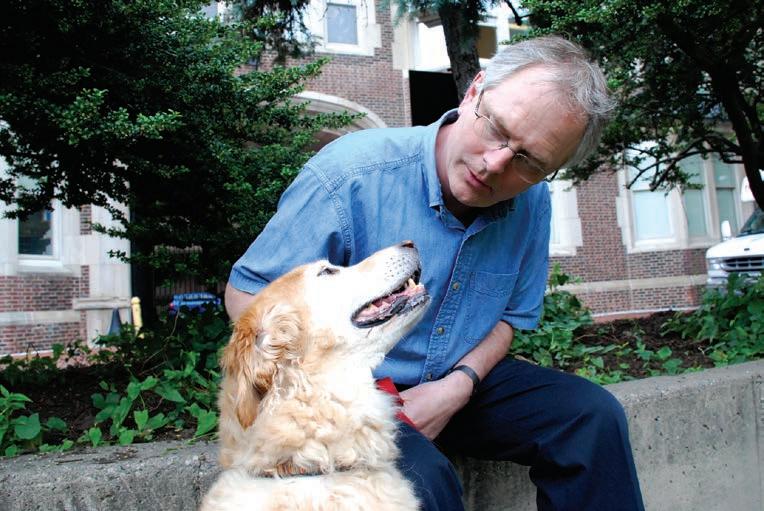
To date, the questionnaire and its results have been used in more than 60 published scientific studies, with more than 30,000 pet dogs and a similar number of working dogs in the database.
Recently, Serpell decided to take the next logical step: develop a behavioral evaluation questionnaire for cats. This year, he unveiled the feline equivalent to the C-BARQ, the Feline Behavioral Assessment and Research Questionnaire, or Fe-BARQ, developed with support from the WALTHAM Foundation. To assemble a set of questions appropriate for felines, however, he and his team had to start from scratch.
“It was an interesting process,” he remarked. After scouring the scientific literature and asking half a dozen cat behavior experts worldwide to review an early draft, it became apparent that analyzing cat behavior comes with a unique set of challenges.
“With dogs, it’s very clear what kind of behaviors are positive and what behaviors are negative,” Serpell noted. “No one likes excessive barking, for example. With cats, it’s not as clear. I suspect some owners are happy with a cat that doesn’t climb the furniture, while other people would be delighted to have a very active, playful cat.”
What’s more, cat behaviors didn’t fall into the same neat categories that dog behaviors did. In analyzing C-BARQ, the researchers came up with 14 distinct factors, or sets of related behaviors. For Fe-BARQ, responses grouped into nearly two dozen discrete factors, an indication that the behaviors of individual cats aren’t easily categorized. A cat that purrs constantly, for instance, may not be any more likely to be sociable than a cat that rarely purrs.
Despite the complexities of analyzing cat behavior, Serpell and colleagues are already beginning to identify patterns using initial data from the Fe-BARQ. A paper by the group published earlier this spring in the Journal of Veterinary Behavior showed a strong association between breed and behaviors such as aggression toward other cats or separation-related problems.
Both the Fe-BARQ and C-BARQ are available online. After completing the questionnaire about a pet, respondents receive a report with assessments of a cat’s scores compared to the breed average in various categories such as activity/ playfulness, sociability with people, and sociability with other animals.
The reports provide a good deal of interesting data, but don’t provide guidance about what a pet owner is to do if a certain type of behavior is a problem.
“The C-BARQ and Fe-BARQ are not diagnostic tools,” said Dr. Carlo Siracusa, Director of Penn Vet’s Behavior Medicine Service. “They tell you how your dog or cat compares with the average population in relation to some temperament traits.”
14 BELLWETHER FALL 2016 RESEARCH BRIEF
“To my surprise and delight, C-BARQ was extremely successful among pet owners, who wanted to know more about their dogs’ behavior. And it has also been taken up by the research community.”
Dr. James Serpell
To take the next step requires a more individualized approach. That’s where a new web portal will come in. Serpell and Siracusa have been working with the company Connect for Education to build a website that will provide pet owners and primary care veterinarians with quality behavioral information and the specialized services of Penn Vet’s behavior experts.
The idea for the portal emerged several years ago. Dongsook Whitehead, the President, CEO, and chief instructional designer of Connect for Education, had been hearing rave reviews about Serpell and Siracusa from her daughter, KimMi Whitehead, V’10. Whitehead approached Serpell to inquire about a possible partnership between the school and her company, which produces webbased instructional materials and services. Together, they envisioned an online tool for offering behavioral consulting services.
The concept took a few years to move forward, but Whitehead, Serpell, and Siracusa are now formalizing a web portal pilot effort set to launch this fall.
Their vision is to build upon the information and services already in place at Penn Vet. While the Behavior Medicine Service has informational sheets online on topics such as house training a new dog or interpreting a pet’s body language, the
portal will allow pet owners to take one of the questionnaires and receive information and links to videos that are tailored to their concerns about their cat or dog.
“The portal is going to be allencompassing,” explained Whitehead. “We’re hoping that people can use the portal to do everything from taking an assessment using C-BARQ or Fe-BARQ, to getting relevant articles and video clips, all the way to uploading videos of a pet’s behaviors and getting time-stamped feedback from a behavioral veterinarian.”
The portal’s clinician-facing side would enable primary care veterinarians to upload medical records and provide videos of patients to Penn Vet’s board-certified behavior experts. In addition to expanding access to veterinarians and clients, Siracusa would like to add a service for animal shelters to help improve the conditions and welfare of animals under their care.
“One thing we stress a lot is the need to provide people, both primary care veterinarians and laypeople, with sciencebased information,” Siracusa said. “There is a lot of what I call ‘pop behavior culture’ with a lot of incorrect and often dangerous information. We want people to have the opportunity to go online, see the Penn Vet name, and know that this is a trusted source of information.”
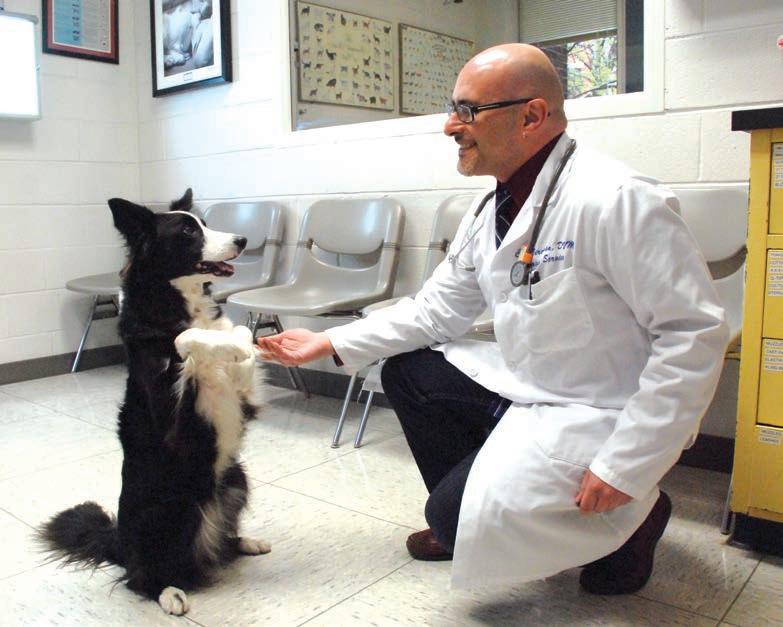
WWW.VET.UPENN.EDU/BELLWETHER 15 RESEARCH BRIEF
“
“We want people to have the opportunity to go online, see the Penn Vet name, and know that this is a trusted source of information.”
DR. CARLO SIRACUSA Director of Penn Vet’s Behavior Medicine Service
DR. MARK HASKINS RETIREMENT PARTY
To honor the retirement of Dr. Mark Haskins, the “Scientific Symposium in Appreciation of Animal Models of Human Genetic Disease” was held in his honor. Reception participants dressed for the occasion, donning long gray wigs and beards. See page 19 to learn about a new scholarship honoring Dr. Haskins’ legacy.

DR. CHRISTOPHER HUNTER NAMED CHAIR
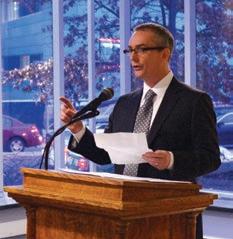
The Penn Vet community celebrated Dr. Christopher Hunter being named the inaugural Mindy Halikman Heyer President’s Distinguished Professor. Pictured (near right, top) are Dr. Phillip Scott and Dean Joan Hendricks, and (near right, bottom) Dr. Christopher Hunter.
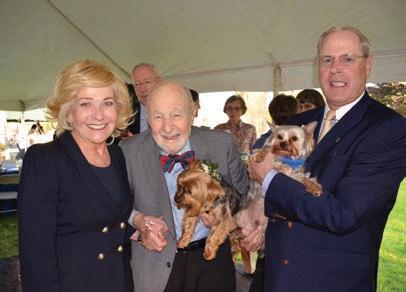
DR. ROBERT MARSHAK CELEBRATION

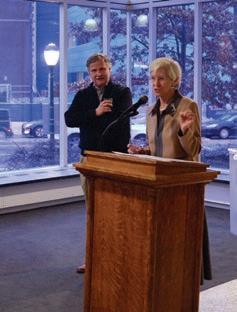
Dr. Robert Marshak was celebrated at New Bolton Center in honor of his 60 years of service to Penn Vet and dedication to the veterinary profession. Dr. Marshak was pictured with (far right, top to bottom) Emeritus Dean Alan Kelly and Dean Joan Hendricks; a calf from the Marshak Dairy; and Shirley and Vernon Hill. See page 20 to read about the Robert Marshak-Vernon Hill Scholarship Fund in collaboration with the Wharton School.
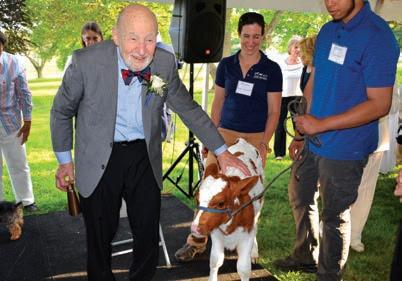
PENNSYLVANIA FARM SHOW
Penn Vet’s booth at the Pennsylvania Farm Show in Harrisburg, Pa., drew visitors of all ages, who spoke with clinicians, students, and staff about Penn Vet, what veterinarians do, and how they serve the Commonwealth of Pennsylvania.


EVENTS 16 BELLWETHER FALL 2016
MARTIN LUTHER KING, JR. DAY OF SERVICE
(At left, top photo) Students are pictured during the seventh annual Martin Luther King, Jr. Day of Service. Penn Vet continued its commitment to the West Philadelphia community by providing free wellness exams to pets from local Philadelphia neighborhoods. The students administered check-ups and vaccines to approximately 250 dogs and cats.
SARCOMA RUN
(At left, second from top) Dr. Nicola Mason participated in Steps to Cure Sarcoma’s second annual walk/run. The event raised over $75,000, which goes to Penn Medicine’s Abramson Cancer Center to aid sarcoma cancer research and treatment.

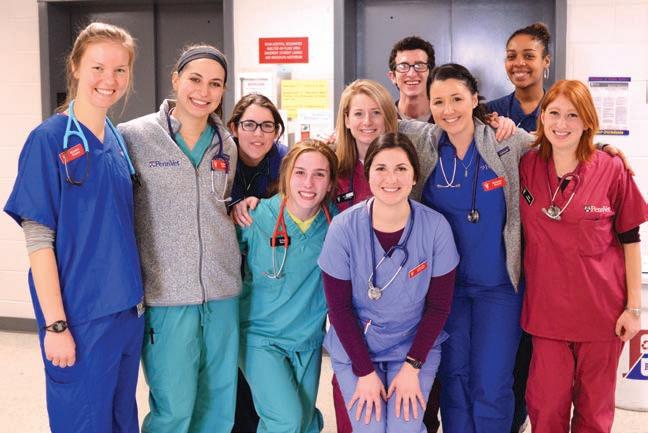
PHILADELPHIA SCIENCE FESTIVAL
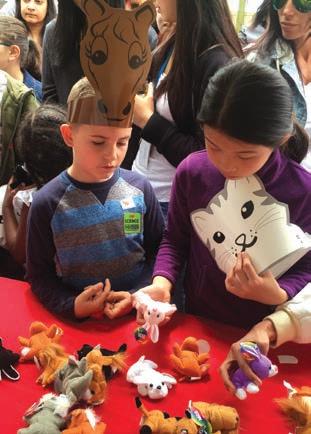
Penn Vet faculty and staff manned a tent at the Philadelphia Science Festival’s Carnival on the Parkway. A MASH Unit helped children mend wounded stuffed animals; “Ask the Vet” experts were on hand to answer veterinary questions; and VETPETS volunteers brought their therapy dogs to interact with the public.
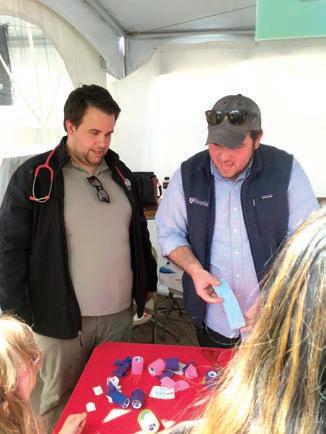
BEST FRIENDS BASH
(Bottom row, left and center) Penn Vet hosted the third annual Best Friends Bash, which brought together craniofacial patients from The Children’s Hospital of Philadelphia with dogs treated by Ryan Hospital’s Department of Dentistry and Oral Surgery. This unique partnership aims to help children see how dogs are affected by similar medical issues and how they have adapted.


YOUNG FRIENDS
(Bottom row, right) The Young Friends of Penn Vet enjoyed a reception at the Devon Horse Show.

ZOOBIQUITY
(Below) Pennsylvania Department of Agriculture Secretary Russell Redding spoke at the closing reception of the Zoobiquity Conference. Experts in veterinary and human medicine presented results and works in progress from collaborative studies. The conference is designed to foster conversations and collaborations that can lead to new ways to diagnose, model, and treat diseases in all species.

WWW.VET.UPENN.EDU/BELLWETHER 17 EVENTS
Penn Vet Welcomes New Overseers
Penn Vet announces the appointment of Bill Levy and Linda Richardson to its Board of Overseers.
Overseer boards serve as bridges between Penn’s schools and centers and the community beyond campus boundaries. The President, Provost, and Board of Trustees rely heavily on these boards to help inform the work of the schools and centers.
“It is with great pleasure that we welcome Bill and Linda to our Board of Overseers. Their expertise and business savvy will benefit both the board and the entire Penn Vet community,” said Penn Vet Dean Joan Hendricks.
Bill Levy
William R. Levy joined Brown Brothers Harriman (BBH) in 1998 and currently serves as President of Brown Brothers Harriman Trust Company of Delaware, N.A. He is responsible for overseeing all facets of trust and estate administration for the Trust Company as well as working with clients in connection with their estate, financial, and charitable planning. He had previously helped establish the Pennsylvania Trust Company for BBH in 1999.
Before joining BBH, Levy held corporate fiduciary roles with Provident National Bank and The Glenmede Trust Company. He also previously practiced law, specializing in estate and trust planning and administration.
He graduated from Trinity College in 1975 and received his JD from Dickinson School of Law in 1978.
Levy is a longtime Penn Vet client and donor; the proud parent of a 2015 Penn Vet graduate as well as four cats; and the grandparent of two Pugs and three cats. He is particularly interested in the School’s translational research in diabetes and cancer as well as the Shelter Medicine Program. He is also Co-Chair of the Leadership Council for the Institute for Diabetes, Obesity, and Metabolism at Penn’s Perelman School of Medicine.
Linda Richardson
Linda Richardson is the Founder of Richardson, a global sales training business, and the author of Changing the Sales Conversation and the New York Times bestseller Perfect Selling A recognized leader in the industry, she won the coveted Stevie Award for Lifetime Achievement in Sales Excellence in 2006 and was named one of the “Top 20 Most Influential Training Professionals” by Training Industry, Inc. in 2007.
Richardson teaches sales and management courses at the Wharton School of the University of Pennsylvania and in Wharton’s Executive Development Program.

She began her career as an educator and educational psychologist before transitioning to the corporate world, where she developed a passion for sales effectiveness.
In addition to authoring ten books on selling and sales management, Richardson has been published extensively in industry and training journals and has been featured in The Wall Street Journal, Forbes, Nation’s Business, Selling Power, Success, and The Conference Board Review magazine. She received a Master of Science degree in Educational Psychology from Temple University.
Richardson, the owner of two Persian cats, has been a Ryan Hospital client for many years. In addition, she has supported Penn Vet research projects focused on cancer and feline health.

18 BELLWETHER FALL 2016 CAMPUS UPDATES
A Commitment to Animals, Pennsylvania, and Penn Vet
By Jillian Marcussen
Pat Jenkins has always been an animal lover, going back to her first family pet—a Manchester Terrier named Chip. She later rescued a kitten while in law school, calling him Frank.
When she met her late husband Matthew J. Ryan, and took on helping to care for his children’s pets, a fondness for Labradors, in particular, was born. Today, Pat is the proud owner of a black Lab named Miracle and three adopted cats: Penelope, Isis, and Mya. She feels like her home isn’t complete unless she is sharing it with both cats and dogs.
Pat notes that Matt’s love for the state of Pennsylvania and her love for animals is what sparked their mutual involvement in Penn Vet. As Speaker of the Pennsylvania House of Representatives for six terms, from 1981 to 1982 and 1995 to 2004, Matt was instrumental in making the case for Penn Vet to both voters and fellow legislators, noting the School’s important role in public health and food safety.
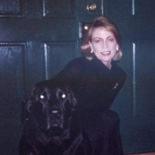
Of her many experiences at Penn Vet, Pat fondly recalls carriage rides at New Bolton Center with Matt and former Deans Mark Allam and Bob Marshak. She was one of the first visitors to the Swine Unit and the Marshak Dairy. In 2003, she was proud to witness the renaming of the small animal hospital in Philadelphia in Matt’s honor.
For nine years, Pat also served on the Penn Vet Board of Overseers, bringing her enthusiasm for the School and its hospital programs to the leadership group. She has been a generous supporter of Ryan Hospital, the Shelter Medicine Program, and the Working Dog Center. Pat became interested in the latter as a result of her many years of service as a Judge for the Delaware County Court of Common Pleas, one of the first to use working and therapy dogs in the courtroom. She has since been appointed to the Superior Court of Pennsylvania, and her new office is appropriately adorned with an array of dog figurines.
Pat’s commitment to Penn Vet will also extend well into the future thanks to thoughtful long-term planning on her part. She has included Penn Vet as a beneficiary of her estate, ensuring that the programs that mean the most to her at the School will benefit. Pat also hopes that Matt’s tireless efforts to showcase the important role that veterinarians play, in the state and beyond, will continue to be part of the School’s success. She notes that Dean Joan Hendricks has made great progress in this regard by demonstrating Penn Vet’s role in advancing One Health.
PLANNED GIVING
To learn more about how you can honor a special pet or veterinarian in your long-term plans, please contact Jillian Marcussen, Director of Development and Board Relations, at 215-898-4235 or jillian2@vet.upenn.edu.
By planning a legacy gift to support Penn Vet, you will receive membership in the Veterinary Heritage Circle, the School’s membership society for planned giving donors, and the University’s Charles Custis Harrison Society.
New Scholarship Honors
Dr. Mark Haskins’ Legacy
For the past 40 years, Penn Vet Pathology Professor Dr. Mark Haskins has been impacting the lives of countless individuals including students, residents, postdocs, and colleagues from around the world. He has been described as a teacher, mentor, counselor, and role model who has given a tremendous amount to the veterinary profession through his dedication to advancing genetic research.
In honor of Haskins’ retirement this year, friends and colleagues gathered in May to celebrate his many career highlights and to announce the newly created Mark Haskins Endowed Scholarship Fund. A total of 109 supporters came together to make the scholarship a reality, and the fund will be used to recruit talented, aspiring veterinarians as they follow in Haskins’ footsteps.
There is still time to join in our efforts with a gift to the Haskins Scholarship. Every contribution increases muchneeded resources for recruitment to ensure that top students choose Penn Vet regardless of financial considerations. Gifts of all sizes have an impact, and can be made by contacting Jillian Marcussen, Director of Development and Board Relations, at 215-898-4235 or jillian2@vet.upenn.edu.
WWW.VET.UPENN.EDU/BELLWETHER 19 CAMPUS UPDATES
Vernon and Shirley Hill Announce $1 Million Scholarship Fund for VMD-MBA Training at Penn Vet and the Wharton School
By Ashley Berke
With a generous $1 million gift from Vernon and Shirley Hill, Penn Vet will establish the Robert Marshak-Vernon Hill Scholarship Fund in collaboration with the Wharton School of the University of Pennsylvania. The fund will support the training of leaders and entrepreneurs with the vision to advance both the science and business of food animal production, in order to help ensure global food security.
The scholarships will support qualified individuals in the Penn Vet community who will pursue the combined VMD-MBA degree at Penn Vet’s Center for Animal Health and Productivity and the Wharton School. Marshak-Hill scholars will be required to develop projects that explore the applications of economic and business principles to the health and productivity of livestock industries.
Vernon Hill, a 1967 undergraduate alumnus of the Wharton School, and his wife Shirley are longtime supporters of Penn Vet. They named the scholarship in honor of Dr. Robert Marshak, Penn Vet Dean from 1973 to 1987. Marshak’s passion for research and teaching in animal health and production has provided a springboard for Penn Vet students to impact world health and global food security.
“Dr. Marshak transformed veterinary medicine, and we are pleased to partner with him as Penn Vet and the Wharton School take the next big step,” said Hill.
The Hills’ generosity to Penn Vet has also included a gift of $10 million in support of the Vernon and Shirley Hill Pavilion, a teaching and research center that opened
in 2006, and the establishment of the Penn Vet World Awards in 2007, an innovative program that encouraged and rewarded visionary thinking and groundbreaking accomplishments in veterinary medicine.
“Vernon and Shirley Hill’s generous gift comes at a time when increasing numbers of veterinary students are expressing interest in how veterinarians can apply their special skills and knowledge to help address the interrelated problems of world hunger, poverty, and food security,” said
20 BELLWETHER FALL 2016 CAMPUS UPDATES
“Vernon and Shirley Hill’s generous gift comes at a time when increasing numbers of veterinary students are expressing interest in how veterinarians can apply their special skills and knowledge to help address the interrelated problems of world hunger, poverty, and food security.”
Dr. Robert Marshak
Marshak. “It is our hope and expectation that the VMDMBA combined-degree program, coupled with mentoring by superb faculty at the Center for Animal Health and Productivity at Penn Vet’s New Bolton Center, will inspire graduates to seek careers in food safety and security in the global landscape.”
The integrated training will emphasize innovative solutions to the complex business, health, environmental, and societal challenges associated with intensive and small-scale livestock and poultry production in a global environment, with a rapidly increasing demand for animalsourced protein. Qualified individuals will benefit from the joint curriculum at two of the nation’s top educational institutions, where they will gain experience in veterinary medicine and business platforms on leadership, economics, finance, competitive strategy, and marketing.
Those completing the multi-year program will obtain their veterinary and MBA degrees and a certificate in Food Animal Production Medicine. Marshak-Hill graduates will have unique qualifications for leadership roles in food animal agribusiness, government, non-governmental organizations, public health, research, and academia.

“At Penn Vet, we benefit from our close proximity to other renowned schools on the University of Pennsylvania campus,” said Penn Vet Dean Joan Hendricks. “We are incredibly grateful to Vernon and Shirley Hill for making this unique interchange of knowledge possible, and for helping us ensure that veterinarians have an important voice in issues of global significance.”
“The value of a Wharton education lies not just in the traditional foundations of business, but in how we apply those principles to other disciplines,” said Geoffrey Garrett, Dean, Reliance Professor of Management and Private Enterprise, and Professor of Management at the Wharton School. “These applications directly impact the critical issues that face our nation and world. With this gift, Vernon and Shirley Hill demonstrate their understanding of how Penn is uniquely suited to address these concerns.”
The combined VMD-MBA degree program at Penn Vet and the Wharton School was established in 1981. Dr. David Galligan, VMD, MBA, Professor of Animal Health Economics and Director of the Center for Animal Health and Productivity at New Bolton Center, will oversee the updated program and will mentor the Marshak-Hill scholars.
WWW.VET.UPENN.EDU/BELLWETHER 21 CAMPUS UPDATES
(From left) Wharton Dean Geoffrey Garrett, Shirley Hill, Vernon Hill, Dr. Robert Marshak, Margo Marshak, and Penn Vet Dean Joan Hendricks
Petco Foundation and Blue Buffalo Foundation Support Penn Vet Cancer Research and Treatment Initiatives
By Ashley Berke
With generous grants from the Petco Foundation and Blue Buffalo Foundation, Penn Vet will advance its Shelter Canine Mammary Tumor Program and launch a cancer treatment support fund at Ryan Hospital for owners who cannot otherwise afford the full cost of cancer treatment for their pets.
“Penn Vet’s remarkable frontline research efforts and treatment options are helping to change the way we approach cancer in both animals and humans,” said Susanne Kogut, Executive Director of the Petco Foundation. “Through these investments, we are proud to support efforts that will help countless pets and families impacted by this disease.”
“Through our partnership with the Petco Foundation, we’re thrilled to support outstanding pet cancer research and treatment initiatives at work across the country,” said David Petrie, President of the Blue Buffalo Foundation. “The inspiring work taking place at Penn Vet exemplifies the critical role that universities and research centers play in understanding and eradicating pet cancer.”
HELPING SHELTER DOGS WITH MAMMARY TUMORS AND WOMEN WITH BREAST CANCER
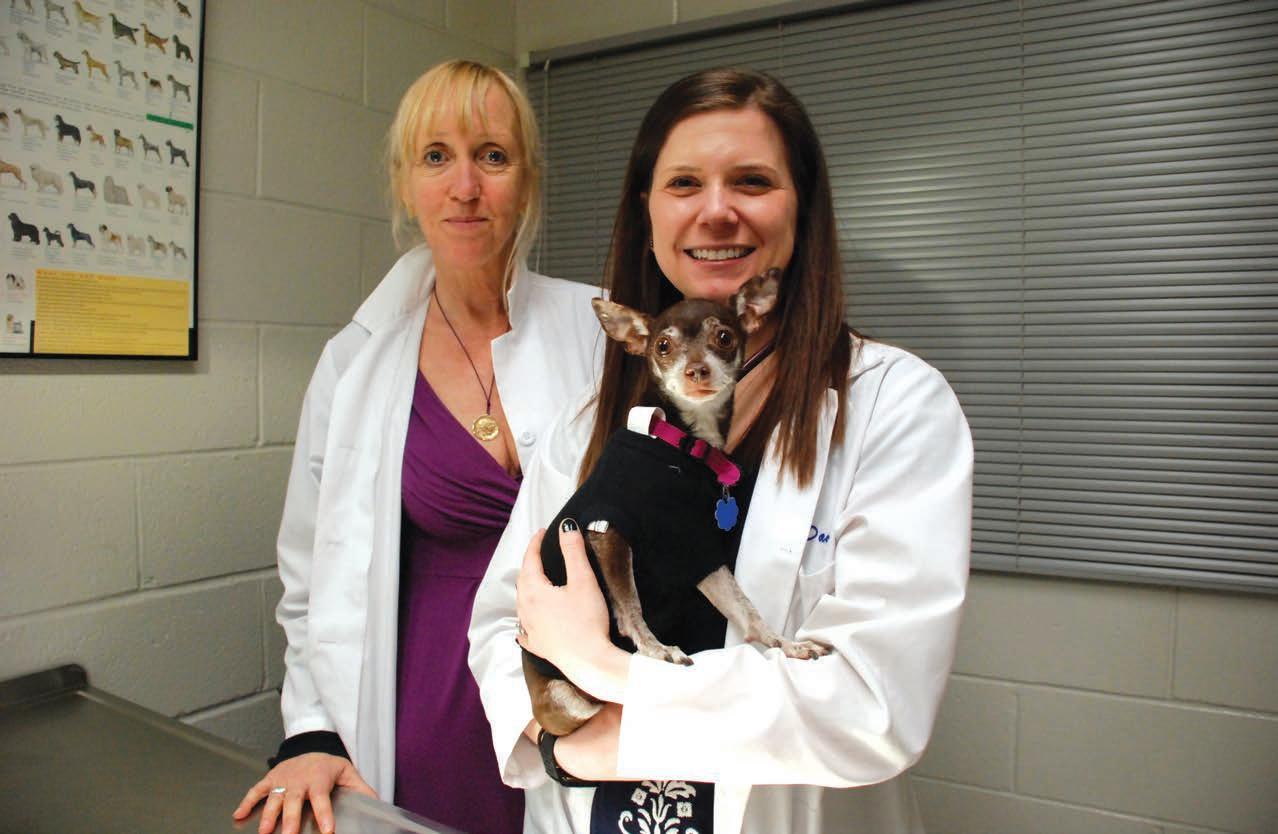
Since 2009, Penn Vet’s Shelter Canine Mammary Tumor Program has provided care for shelter dogs with mammary tumors while advancing knowledge of both canine and human breast cancer. Founded and led by Dr. Karin Sorenmo, Professor of Oncology, the program aids homeless dogs without access to the care they need to survive. The program covers surgery and follow-up care costs and helps facilitate adoption.
The two-year, $525,000 grant from the Petco Foundation and Blue Buffalo Foundation will enable Sorenmo to continue her work in improving understanding of how cancer develops and finding better and more efficient drugs to treat and prevent cancer in both dogs and humans.
Shelter dogs provide an ideal population for studying mammary tumors because only 10 percent of animals received into shelters have been spayed or neutered. The
22 BELLWETHER FALL 2016 CAMPUS UPDATES
Professor of Oncology Dr. Karin Sorenmo, at left, founded and runs Penn Vet’s Shelter Canine Mammary Tumor Program. She is pictured with Kiley Daube, DVM, and patient Brownie.
incidence of mammary tumors in unspayed female dogs is at least four times greater than in spayed dogs.
Mammary tumors in dogs and breast cancer in women have many similarities, both in terms of risk factors and biology. Many of the dogs in Penn Vet’s program have multiple tumors, often in different stages of malignant transformation, providing a unique opportunity to research cancer progression.
“Thanks to this very generous support, we can elucidate the complex biology of breast cancer while at the same time saving the lives of some of the most vulnerable members of animal shelter populations,” said Sorenmo. “It truly is a win-win situation.”
HELPING PETS WITH CANCER WHOSE OWNERS CANNOT AFFORD CARE
Cancer is a diverse and complex disease with a wide range of clinical outcomes. Treatments can include chemotherapy, surgery, radiation therapy, and supportive care. And many patients require a combination of these treatments. In addition to navigating these options, clients also face significant financial considerations.
Thanks to a three-year, $350,000 grant, Penn Vet’s Ryan Hospital will launch the Petco Foundation & Blue Buffalo Foundation Cancer Treatment Support Fund to provide financial assistance to pet owners who cannot afford cancer treatments.
“As a veterinarian who is trained to deliver the best in compassionate care, it is profoundly difficult, on both a

professional and personal level, to experience the grief of a pet owner who has to euthanize a pet because the treatment is unaffordable,” said Dr. Erika Krick, Assistant Professor of Oncology. “Thanks to this generous grant, these emotionally overwhelming and devastating experiences can now be transformed into moments of hope.”
Owners in need will now have access to top cancer experts and treatments in the field at Penn Vet’s Ryan Hospital. The fund will cover initial treatment costs for cats and dogs needing recommended, standard-of-care, urgent cancer treatment. The animals must otherwise be in adequate health and be expected to have a good quality of life following treatment. Additional parameters may apply.
WWW.VET.UPENN.EDU/BELLWETHER 23 CAMPUS UPDATES
“Thanks to this very generous support, we can elucidate the complex biology of breast cancer while at the same time saving the lives of some of the most vulnerable members of animal shelter populations.”
Dr. Karin Sorenmo, Professor of Oncology
Diamond, a patient in the Shelter Canine Mammary Tumor Program, has her sutures removed by (from left) Jessica Bosco, CVT, Julie Gee, V’17, and Heather Rudolph, CVT.
FACULTY AND STAFF NEWS
Gustavo Aguirre, VMD, PhD, was awarded the 2017 Proctor Medal for his research in ophthalmology from the Association for Research in Vision and Ophthalmology (ARVO). He is the first veterinarian to be granted the Medal in its 67-year history. The Proctor Medal honors excellence in the basic or clinical sciences as applied to ophthalmology. The award will be presented at the 2017 ARVO meeting, where Aguirre also will deliver the Proctor Lecture. Aguirre’s research area is the molecular basis of inherited blindness. His team uses dog models to study the genetic mechanisms behind vision impairment. His research spans several vision disorders, including Leber’s congenital amaurosis, Best disease, and retinitis pigmentosa. Aguirre’s approach to developing genetic therapies for dogs with Leber’s congenital amaurosis has paved the way to clinical trials in humans, currently underway.
William Beltran, DVM, PhD, received a 2016 Pfizer Ophthalmics Carl Camras Translational Research Award from the Association for Research in Vision and Ophthalmology (ARVO).
Rumela Chakrabarti, PhD, was an invited speaker at the Stem Cell Niche and Cancer Microenvironment meeting at CedarsSinai Medical Center, University of California, Los Angeles, last November. In April, she spoke at the 7th International p63/p73 Workshop in Boston.

Raimon Duran-Struuck, DVM, PhD, was awarded the Premi Extraordinari de Doctorat en Inmunologia Avançada in April from the Autonomous University of Barcelona. The award is given to the best PhD thesis within each specific academic discipline. Duran was the recipient of the advanced immunology award based on his long-term work focused in hematopoietic stem cell transplantation and immunological tolerance.
Amy Durham, VMD, was invited to give a four-hour lecture series in June at the University of Perugia, Italy, on the WHO classification system for hematopoietic neoplasms and subtyping lymphomas in dogs, cats, and horses. Durham was also the invited keynote speaker at the Australian Society of Veterinary Pathology Annual Meeting, which took place from July 15 to 17 in the city of Townsville in Queensland, Australia. She spoke on multiple topics in hematopoietic pathology.
Karina Guziewicz, PhD, delivered a talk on AAV-mediated Therapy for Best Vitelliform Macular Dystrophy in March at

the Translational Research Acceleration Program Meeting in Baltimore.
Mark Haskins, VMD, PhD, gave two talks in April at “The Brain and MPS: Today and Tomorrow” event in Stockholm, Sweden. His topics were What can we learn from animal models and Gene therapy. He published the following [vet students’ names in bold]: Peck, SH, O’Donnell, P, Kang, JL, Malhotra, NR, Dodge, GR, Pacifici, M, Shore, EM, Haskins, ME, Smith, LJ (2015) Pinpointing the Earliest Manifestations of Bone Disease in Mucopolysaccharidosis VII Dogs. J Mol Genet Metab. 2015 Nov;116(3):195-203. doi: 10.1016/j.ymgme.2015.09.008. Epub 2015 Sep 26. He also published: Flanagan-Steet H, Aarnio M, Kwa, B, Guihard P, Petrey A, Haskins M, Steet R (2016) Cathepsin-mediated alterations in TGF-related signaling underlie disrupted cartilage and bone maturation associated with impaired lysosomal targeting. J Bone Miner Res. 2016 Mar;31(3):535-48. doi: 10.1002/jbmr.2722. Epub 2015 Oct 13. Additionally, he published: Gurda, BL, De Guilhem De Lataillade, A, Bell, A, Wang, P, Ponder, KP, Bagel, J, Hinderer, C, Yox, AD, Steet, RA, Louboutin, J-P Casal, M, Wilson, JW, and Haskins, ME (2016) Evaluation of AAV-mediated gene therapy for canine mucopolysaccharidosis VII. Molec Therapy Oct 8. doi: 10.1038/mt.2015.189. [Epub ahead of print]. He also published: Pang, B, Yee, KK, Lischak, FW, Rawson, NE, Haskins, ME, Wysocki, CJ, Craven, BA, Van Valkenburgh, B (2016) The influence of nasal airflow on respiratory and olfactory epithelial distribution in the domestic cat (Felis catus) and bobcat (Lynx rufus). J Exp Biol. 2016 Apr 4. pii: jeb.131482. [Epub ahead of print]
Haskins also published the following: Ruane, T, Haskins, M, Cheng, A, Aguirre, G, Knox, VW, Qi, Y, Tompkins, T, O’Neill, CA (2016) Pharmacodynamics, Pharmacokinetics and Biodistribution of Recombinant Human N-Acetylgalactosamine 4-Sulfatase after 6 Months of Therapy in Cats using Different IV Infusion Durations. Molecular Genetics and Metabolism 117 (2016) 157–163. Additionally, he published: Callan, MB, askins, ME, Wang, P, Zhou, S, High, KA, Arruda, VR (2016) Successful phenotype improvement following gene therapy for severe hemophilia A in privately owned dogs. PLoS One. 2016 Mar 24;11(3):e0151800. doi: 10.1371/journal.pone.0151800. Lastly, he published the following: Simonaro, CM, Tomatsu, S, Sikora, T, Frohbergh, M, Guevara Morales, JM, Wang, RY, Vera, M, Smith, L, Kang, J, Schuchman, EH, Haskins, ME, (2016) Pentosan Polysulfate: Oral Versus Subcutaneous Injection in Mucopolysaccharidosis Type I Dogs. PLoS One. 2016 Apr 11;11(4):e0153136. doi: 10.1371/journal.pone.0153136.

24 BELLWETHER FALL 2016 CAMPUS UPDATES
HASKINS GUZIEWICZ CHAKRABARTI
DR. TRACY BALE RECEIVES NIH MERIT AWARD



Tracy Bale, PhD, Professor of Neuroscience and Director of Penn Vet’s Neuroscience Center, received a MERIT (Method to Extend Research in Time) Award for her recently funded R01 MHI08286 on Paternal Stress Epigenetics The award converts a five-year grant into a ten-year grant. MERIT awardees cannot apply for the award; they are nominated by the funding NIH institute from a large pool of competing award recipients and then endorsed by an advisory council.
Less than five percent of NIH-funded investigators are selected to receive MERIT Awards, which are designed to give productive and creative scientists long-term support, without the burden of constantly devoting time and staff resources to applying for new grants to fund their research. NIH created the MERIT Award program in 1986, to support investigators whose research skills and productivity are “distinctly superior” and who are highly likely to continue to perform in an outstanding manner.
Christopher Lengner, PhD, provided invited seminars at the Center for Regenerative Medicine, Dongguk University, Seoul Korea; Mount Sinai Icahn School of Medicine Black Family Stem Cell Institute; Wistar Institute; and the Cold Spring Harbor Laboratory Stem Cell Meeting. He published the following [lab members’ names in bold]: Park H, Kim HW, Yoo JS, Lee J, Choi H, Baek S, Lee CJ, Lengner CJ, Sung JS, and Kim J. “Homogenous generation of iDA neurons with high similarity to bona fide DA neurons using a drug-inducible system” Biomaterials 2015 Dec;72:152-62. doi: 10.1016/j. biomaterials.2015.09.002. Epub 2015 Sep 6. He also published: Li N, Yousefi M, Nakauka-Ddamba A, Li F, Vandivier L, Parada K, Woo DH, Wang S, Naqvi AS, Rao S, Tobias J, Cedeno R, Minuesa G, Katz Y, Barlowe TS, Valvezan AJ, Shankar S, Deering RP, Klein PS, Jensen S, Kharas MG, Gregory BD, Yu Z, Lengner CJ. “The Msi family of RNA binding proteins function redundantly as intestinal oncoproteins” Cell Reports, 2015 Dec 22;13(11):244055. doi: 10.1016 PMCID in process. In addition, he published: Katlinskaya YV, Katlinski KV, Lasri A, Li N, Beiting DP, Durham AC, Yang T, Pikarsky E, Lengner CJ, Johnson FB, Ben-Neriah Y, Fuchs SY. “Type I interferons control proliferation and function of the intestinal epithelium” Mol Cell Biol. 2016 Jan 25;36(7):1124-35. doi: 10.1128/MCB.00988-15.
Lengner also published: Taggart J, Ho TC, Amin E, Xu H, Barlowe TS, Perez AR, Durham BH, Tivnan P, Okabe R, Chow A, Vu L, Park SM, Prieto C, Famulare C, Patel M, Lengner CJ, Verma A, Roboz G, Guzman M, Klimek VM, Abdel-Wahab
O, Leslie C, Nimer SD, Kharas MG. “MSI2 is required for maintaining activated myelodysplastic syndrome stem cells” Nature Communications 2016 Feb 22;7:10739. doi: 10.1038/ ncomms10739. PMCID in process. In addition, he published: Cieply B, Park JW, Nakauka-Ddamba A, Bebee TW, Guo Y, Shang X, Lengner CJ, Xing Y, Carstens RP. “Multiphasic and dynamic changes in alternative splicing during induction of pluripotency are coordinated by numerous RNA-binding proteins” Cell Reports 2016 Apr 12;15(2):247-55. doi: 10.1016/j. celrep.2016.03.025. Epub 2016 Mar 31. Lastly, he published: Li N, Nakauka-Ddamba A, Tobias J, Jensen ST, Lengner CJ “Mouse Label-Retaining Cells are Molecularly and Functionally Distinct from Reserve Intestinal Stem Cells” Gastroenterology, 2016 May 26. pii: S0016-5085(16)34493-6. doi: 10.1053/j. gastro.2016.04.049. [Epub ahead of print]
Meryl Littman, VMD, Chair of the American College of Veterinary Internal Medicine (ACVIM) Small Animal Lyme Consensus Update, presented the group’s findings at the ACVIM National Forum in Denver, Colorado, in June.
Nicola Mason, BVetMed, PhD, published the following: Immunotherapy with a HER2 targeted Listeria induces HER2specific immunity and demonstrates potential therapeutic effects in a phase I trial in canine osteosarcoma. CCR 2016 Clin Cancer Res. 2016 Mar 18. Mason N, Gnanandarajah J, Engiles J, Gray F, Laughlin D, Gaurnier-Hausser A, Wallecha A, Huebner M, Paterson Y.
WWW.VET.UPENN.EDU/BELLWETHER 25 CAMPUS UPDATES
LITTMAN LENGNER BALE
FACULTY AND STAFF NEWS
Erin McGowan, VMD, was selected for the grand prize in BlackwellKing’s Resident of the Year contest, out of more than 100 residents across the United States and Canada.

Keiko Miyadera, DVM, PhD, published the following: Canine genome assembly correction facilitates identification of a MAP9 deletion as a potential age of onset modifier for RPGRIP1associated canine retinal degeneration in the journal Mamm Genome. 2016 Mar 26. The authors were Oliver P. Forman, Rebekkah J. Hitti, Mike Boursnell, Keiko Miyadera, David Sargan, and Cathryn Mellersh.

Cynthia Otto, DVM, PhD, has recently spoken at events for the North American Veterinary Community (NAVC), the Israel Companion Animal Veterinary Association, and the Working Dog Organizations of Israel (police, Army, Air Force, prison, and sport). She also testified before the Senate Homeland Security Committee. In addition, the Penn Vet Working Dog Center K9 Performance Medicine service—Dr. Otto and Tracy Darling, RVT, VTS—is providing conditioning and rehabilitation services for police, working, and performance dogs.
PENN VET EDUCATORS HONORED

This year’s Zoetis Distinguished Teacher Award was presented to Mark Oyama, DVM The Zoetis Distinguished Teacher Award is the most prestigious teaching award in veterinary medicine. It is presented annually to a faculty member at each school of veterinary medicine in the United States. Its purpose is “to improve veterinary medicine education by recognizing outstanding instructors who, through their ability, dedication, character and leadership, contribute significantly to the advancement of the profession.” The entire Penn Vet student body votes on the recipient.
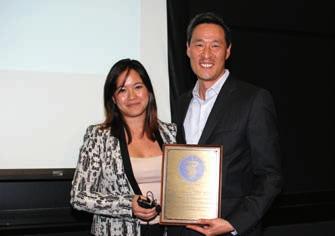
James “Sparky” Lok, DVM, PhD, received the Dean’s Distinguished Service Award. “The fundamental criterion for the Dean’s Distinguished Service Award, which Sparky meets and exceeds, is that he has contributed beyond our ability to thank him throughout his long career at Penn Vet. He is a creative, committed, and passionate researcher in important areas of global health,” said Penn Vet Dean Joan Hendricks. She added, “His impact is perhaps best captured by the response every student, faculty, or staff member had when I told them he was getting this award. They said, emphatically, ‘I love Sparky!’”
Nicole Scherrer, DVM, received the William B. Boucher Award, which honors a house officer at New Bolton Center for excellent teaching, as was exemplified by William Boucher over four decades at Penn Vet.

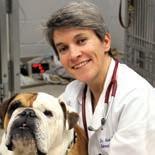
26 BELLWETHER FALL 2016 CAMPUS UPDATES
MASON MIYADERA M c GOWAN
NICOLE SCHERRER, DVM
MARK OYAMA, DVM
JAMES “SPARKY” LOK, DVM, PHD
ANGUERA SIERRA BOYLE
GRANTS
Alexander Reiter, Dr med vet, Dipl. Tzt., gave invited presentations during the Annual Meeting of the Edwin and Fannie Gray Hall Center for Human Appearance (CHA) in Ardmore, Pennsylvania, last November; an Oral and Maxillofacial Trauma Surgery Course in Halmstad, Sweden in February; the Congress of the Austrian Society of Veterinary Dentistry (OEGTZ) in Innsbruck, Austria in February; the Vetmadrid-Propet Congress in Madrid, Spain in March; the Penn Multi-Disciplinary Consortium (Personalized Dental, Oral and Craniofacial Tissue Regeneration) Research Retreat in Philadelphia in March; the European Congress of Veterinary Dentistry in Dublin, Ireland in May; and the Eurocongress of the Federation of European Companion Animal Veterinary Associations (FECAVA) in Vienna, Austria, in June.
Lila K. Sierra, CVT, VTS (ECC), will be stepping down after 16 years serving as the assistant nursing supervisor of ICU to become the first newly appointed Nursing Coordinator of Penn Vet Cardiology.


Charles Vite, DVM, PhD, was recognized this month as part of the 2016 Champions of Hope in Collaborations in Science and Technology. He was honored for his work with the SOAR-NPC Collaborative of parents and scientists, striving to find therapies for Niemann Pick type C disease. Each year, Global Genes—a leading global rare disease patient advocacy organization—asks for nominations for those deserving of recognition for their extraordinary efforts in rare disease; Vite was recognized at an awards ceremony and also at the annual Tribute to Champions of Hope Gala. In addition, he spoke in June at the Ara Parseghian Medical Research Conference on autophagy in Niemann-Pick type C disease, and at the ACVIM Forum in Denver, Colorado, on developing new therapies for globoid cell leukodystrophy. He published the following: Crowdsourcing reproducible seizure forecasting in human and canine epilepsy. Brinkmann BH, Wagenaar J, Abbot D, Adkins P, Bosshard SC, Chen M, Tieng QM, He J, Muñoz-Almaraz FJ, Botella-Rocamora P, Pardo J, Zamora-Martinez F, Hills M, Wu W, Korshunova I, Cukierski W, Vite C, Patterson EE, Litt B, Worrell GA. Brain. 2016 Jun;139:1713-22.
Jackie Watson, Research Specialist at New Bolton Center, received a Master of Science in Laboratory Animal Science from Drexel University in May.
Victor Absalón-Medina, DVM, PhD, received a $1,749,448 grant from Li Animal Health for Evaluation and optimization of culture media for in vitro embryo purposes using mammalian eggs The grant spans from January 1, 2016, to December 31, 2018.
Montserrat Anguera, PhD, received a two-year, $250,000 grant from Research Careers in Women’s Health for K12 BIRCHWH Scholars. The grant spans from January 1, 2016, to December 31, 2018.

Michael Atchison, PhD, received a $1,401,161 NIH/NIAID/R01 grant for Control of B Cell Development by YYI The grant spans from December 1, 2015, to November 30, 2020.
William Beltran, DVM, PhD, received a $1,876,891 NIH-NEI grant for Translational Gene Therapy for Rhodopsin The grant spans from March 2016 to February 2017. Collaborators include Drs. Cideciyan and Jacobson, Scheie Eye Institute, and Drs. Hauswirth and Lewin, University of Florida. Beltran also received a $1,113,049 grant from AGTC, Inc. for SRA Amended Canine GLP-like ocular toxicology and efficacy studies in dogs The grant spans from January 2016 to September 2019, and he is collaborating with Gustavo Aguirre, VMD, PhD
Ashley Boyle, DVM, received a one-year, $22,330 grant from Grayson Jockey Club for Validation of stall–side strangles diagnosis using LAMP The grant spans from April 1, 2016 to March 31, 2017. She also received a one-year, $15,000 grant from Boehringer Ingelheim for Validation of a point-of-care self-heating, microfluidic cartridge for isothermal nucleic acid amplification of Streptococcus equi subsp equi The grant spans from December 1, 2015, to November 30, 2016.
Allison Bradbury, PhD, received a $226,800 grant from Legacy of Angels Foundation for Lentiviral-mediated Hematopoietic Stem Cell Gene Therapy for Canine Globoid Cell Leukodystrophy The grant spans from November 1, 2015, to December 31, 2018.
Rumela Chakrabarti, PhD, received a three-year, $574,501 NCI-K22 award to explore the tumor suppressive role of Elf5 in different subtypes of breast cancer; identify genes and pathways in preneoplastic mammary gland and tumors affected by Elf5 loss; and evaluate the pathological role of loss of Elf5 in human patient derived xenograft (PDX) tumors.
WWW.VET.UPENN.EDU/BELLWETHER 27 CAMPUS UPDATES
GRANTS, CONT’D
David Galligan, VMD, MBA, received a three-year, $339,750 grant from Wharton China Center for the Penn Vet & Wharton Dairy Training Program. The grant spans from December 1, 2015, to November 30, 2018.

Urs Giger, Dr med vet, and Keijiro Mizukami, DVM, PhD, received a $106,000 grant from the AKC Canine Health Foundation for the study of the Genetic Predisposition to Avian Tuberculosis in Miniature Schnauzers Mizukami also received a prestigious postdoctoral fellowship from the Japanese Society for the Promotion of Sciences to work in Giger’s Laboratory on this and other canine genetic conditions.
Manti Guha, PhD, received a $50,000 grant from University Research Foundation for Establishing the Contribution of mtDNA Depletion Towards Metastasis Using a Novel PDX Model Guha also received a two-year, $125,000 grant from the Breast Cancer Alliance for Reduced mitochondrial DNA copy number is a determinant of breast cancer metastasis The grant spans from February 1, 2016, to January 31, 2018.

Karina Guziewicz, PhD, received a $959,074 grant from the Foundation Fighting Blindness for AAV-Mediated Therapy for Best Vitelliform Macular Dystrophy The grant spans from January 1, 2016, to December 31, 2017. Collaborators are Gustavo Aguirre, VMD, PhD, and William Beltran, DVM, PhD; Samuel Jacobson, MD, PhD, and Artur Cideciyan, PhD, Scheie Eye Institute at Penn Medicine; Drs. Hauswirth and Lewin, University of Florida; and Dr. Gamm, University of Wisconsin.
Erika Krick, VMD, received a one-year, $5,000 grant from Cytosorbents Corp. for Effects of hemoabdsorption on cytokine removal and quality of life in cats with cancer The grant spans from September 15, 2015, to September 14, 2016.
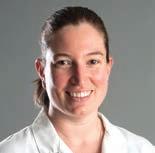
Christopher Lengner, PhD, received a $1,448,252 NIDDK R01DK106309 grant for Control of intestinal regeneration by an Msi-mTorc1 signaling axis, spanning from May 15, 2016, to April 30, 2020. The grant investigates the molecular mechanisms governing intestinal stem cell activation with the goal of manipulating these mechanisms to address pathological conditions affecting intestinal regeneration, including ischemia-reperfusion injury and radiation enteropathy.
Nicola Mason, BVetMed, PhD, received a one-year, $186,219 grant from the Richard Lichter Charity for Dogs for Re-Directed T Cell Therapy in Dogs with B Cell Lymphoma The grant spans from December 1, 2015, to November 30, 2016. She also received a one-year, $40,955 Animal Cancer Foundation Comparative Oncology Grant. She will be building on current work that has led to the first clinical trial evaluating the safety and therapeutic effect of CD20 targeted CAR T cell therapy in client-owned dogs with relapsed B cell lymphoma. Mason aims to investigate the use of alternative intracellular signaling domains that may lead to improved CAR T cell engraftment and persistence in vivo, factors that have contributed to the unprecedented success of this approach in human patients. The work continues a strong collaboration between the Schools of Veterinary Medicine and Medicine at the University of Pennsylvania, where the use of CAR T cell technology has led to durable remissions and potential cures for human patients with B cell malignancies. Mason is affiliated with the laboratory of Carl June, MD, and she is collaborating with Avery Posey, PhD, both from Penn’s Perelman School of Medicine.
Sue McDonnell, PhD, received a $12,500 grant from Merck for a Merck 2015 IN Applicator Behavior Clinical Trial, from January 1, 2016, to June 30, 2016.
Keiko Miyadera, DVM, PhD, received a $50,000 grant from University Research Foundation for Molecular Characterization of a Multigenic Canine Model of Retinal Degeneration. The grant spans from May 1, 2016, to April 30, 2017. Miyadera also received a one-year, $69,934 grant from Burrows Enterprises for Clinical & Safety Evaluation of Burr-1 Drops for the Treatment of Dogs with Cataracts The grant spans from November 9, 2015, to November 8, 2016.
Angelica Ortiz, PhD, received a two-year, $110,412 NIH/NCI F32-CA-206431 grant for IFNARI downregulation in melanoma cells and stromal cells promotes melanoma progression and pulmonary metastasis The grant spans from September 1, 2016, to August 31, 2018.
Cynthia Otto, DVM, PhD, received a one-year, $11,340 grant from AKC-CHF for Medical Surveillance of Dogs Deployed to the World Trade Center and the Pentagon 2015-Completion The grant spans from December 1, 2015, to November 30, 2016.
28 BELLWETHER FALL 2016 CAMPUS UPDATES
GUHA KRICK GALLIGAN
Dipti Pitta, PhD, received a $300,000 grant from Purina Animal Health for the Honey Bee Gut Microbiome Project. The grant spans from March 1, 2016, through February 28, 2019.

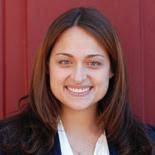
Shelley Rankin, PhD, received a one-year, $16,500 grant from the American College of Veterinary Dermatology for A Molecular Bead-Based Assay for Molecular Detection of Cutaneous Infectious Organisms Stephen Cole, VMD, is a project collaborator.
Thomas Schaer, VMD, received a $49,800 grant from the Orthopaedic Association for Evaluation of Local Tissue Concentrations and Bioactivity of Vancomycin Eluted from PMMA Implants in an Ovine Fracture Healing Model The grant spans from January 1, 2016, to December 31, 2017.
Dieter Schifferli, PhD, Dr med vet, received a $275,000 NIH R21-AI-112713 grant for Genetic determinants of systemic hostadapted Salmonella The grant spans from February 15, 2016, to January 31, 2018.
Phillip Scott, PhD, received a $1,166,248 U01 AI088650 grant for The role of innate cells in the pathogenesis of Leishmania braziliensis infection The grant spans from January 1, 2016, to December 31, 2019.
James Serpell, PhD, received a $20,356 grant from Tufts University for the Animal Ownership Interaction Study, from January 1, 2016, to October 31, 2017.
Karin Sorenmo, DVM, and Susan Volk, VMD, PhD, received a $28,235 grant from the Greater Good Foundation for The role of collagen in directing canine mammary tumor progression The grant spans from January 1, 2016, to December 31, 2016.
Oriol Sunyer, PhD, received a three-year, $500,000 USDA NIFA award for Collaborative Immune Reagent Network: Aquacultured Species to generate antibody reagents The award spans from May 1, 2016, to April 30, 2019. Sunyer also received a $420,665 NSF IOS-1457282 grant for Evolution of Mucosal B Cell Immunity: Novel Roles of IgT+ B Cells in the Control of Host-pathogen Interactions. The grant spans from August 15, 2015, to July 31, 2018.

Charles Vite, DVM, PhD, received a five-year, $2,747,191 NIH – NINDS grant. The R01 grant focuses on the development of new therapies for globoid cell leukodystrophy, which occurs in both dogs and human patients. He also received a one-year, $45,000 grant from the Institute for Translational Medicine and Therapeutics for the ITMAT Pilot Program in Comparative Animal Biology, cell-based therapy for seizures by transplantation of human stem cell-derived inhibitory interneurons modified for rapid maturation-study in dogs. The grant spans from February 1, 2016, to January 31, 2017. In addition, he received a one-year, $8,000 grant from the University of Pittsburgh (Legacy of Angels Foundation flowdown) for Treatment of Krabbe Disease Using Intravenous Adeno-Associated Virus Gene Therapy The grant spans from December 1, 2015, to November 30, 2016. He also received a $53,500 grant and a $50,500 grant from the Million Dollar Bike Ride Program for Targeted AAV gene therapy for vertical supranuclear gase palsy and dysphagia and Natural history study and biomarker development in the large animal model of mucolipidosis II, respectively. The grants span from January 1, 2016, to December 31, 2016.
Jeremy Wang, PhD, MD, received a $2,797,601 NIH MIRA R35GM118052 grant for Regulation of meiosis in mice. The grant spans from May 2016 through April 2021.
Brittany Watson, VMD, PhD, received a one-year, $206,422 grant from PetSmart Charities for the Penn Vet Shelter Medicine Surgical Program. The grant spans from December 1, 2015, to November 30, 2016.
WWW.VET.UPENN.EDU/BELLWETHER 29 CAMPUS UPDATES
WATSON SUNYER
PITTA
STUDENT NEWS
Sarah Colmer, V’17, Raisa Glabman, V’17, Justin Krumm, V’17, Matt Lanza, V’17, Joanna Gardiner, V’18, Holden Jensen, V’18, Brianna Parsons, V’18, Ben Turchin, V’18, Molly Larson, V’19, Katie Pruett, V’19, and Adriana Wilford, V’19, visited Haiti in June with Pou Sante Amar Haiti, a student-run nonprofit. The organization visits communities in Northern Haiti each year to work with farmers and hold livestock health clinics. During the clinics, students examine each animal, vaccinate and deworm them, and address any health problems they encounter. They also hold community meetings with local farmers to discuss agricultural problems they face each year, and try to together create solutions for these issues. This year, the Penn Vet team created medical kits with basic medications and supplies to leave with a few farmers they have developed relationships with over the past four years. They provided detailed protocols, with Haitian Creole translations and pictorial representations for each disease. “Through these kits, we hope these farmers will gain ownership over their animals’ health, which will result in increased animal productivity and thereby economic stability for these farmers’ families over time,” explained Parsons. To learn more, visit www.pousantehaiti.org.
Sarah Colmer, V’17, received the 2016 Penn Vet Tucker Endowed Scholarship ($10,000), awarded to a New Jersey resident who is pursuing equine medicine.
Benjamin Donati, V’17, recently received the Simmons Educational Fund’s Business Aptitude Award, presented annually to one student at each veterinary school. The award was presented in recognition of his response to the prompt: “What does it mean for a practice to be financially healthy, and why does it matter?” After graduating, Donati plans to get a Bernese Mountain Dog as a friend for his Newfoundland, Wellington, and one day become a practice owner.
This spring, Jonathan Madara, V’17, won the inaugural OIE Knowledge Olympics competition in the veterinary student group for the Americas region. He received his award in May during the opening ceremonies for the 84th General Session of the OIE in Paris, France. He and his wife, VMD-PhD student Noelle Knight, were able to attend and meet with the U.S. delegation to the OIE, the World Organisation for Animal Health.
The Morris Animal Foundation selected Sophie Eiger, V’18, to receive the Veterinary Student Scholar Award. Eiger’s awardwinning project is for her study on determining if targeting of surrounding non-malignant cells that support the growth and spread of tumor cells is effective as a novel approach to treating canine mammary gland tumors. Ellen Puré, PhD, Chair of the Department of Biomedical Sciences, is her mentor.
Jessica Applebaum, V’18, and Rebecca Miller, V’18, Student Chapter of the American Veterinary Medical Association (SCAVMA) Philanthropy Co-Chairs, helped Penn Vet raise over $3,000 for Josh and Friends, an organization that helps support children in hospitals through the human-animal bond. Through donations raised at the SCAVMA Auction, the Chili Cook-off, and cookbook sales, Penn Vet won second place out of all other vet schools in the SCAVMA Josh Challenge. Applebaum and Miller thank all who helped support the cause.
In June, Hannah Cooper, Martina Jackson, Amber Lee, and Louisa Petronis, all V’18, and William Ciancarelli and Christina Murphy, both V’19, spent three weeks in Italy and France to learn about international animal welfare and public policy. Joined by faculty Carlo Siracusa, DVM, PhD, and Thomas Parsons, VMD, PhD, the students studied at the Istituto Zooprofilattico Sperimentale dell’Abruzzo e del Molise in Teramo, Italy, and the Institut de Recherche en Semiochimie et Ethologie Appliquée in Apt, France. Read about their experiences at https://pennwetravels.wordpress.com.
William Ciancarelli, V’19, is receiving a full military scholarship. Patricia Sertich, VMD, is his mentor, and he was inducted in the Old Quad Courtyard.

30 BELLWETHER FALL 2016 CAMPUS UPDATES
WILLIAM CIANCARELLI, V’19
Penn Vet Student Named HHMI Medical Research Fellow
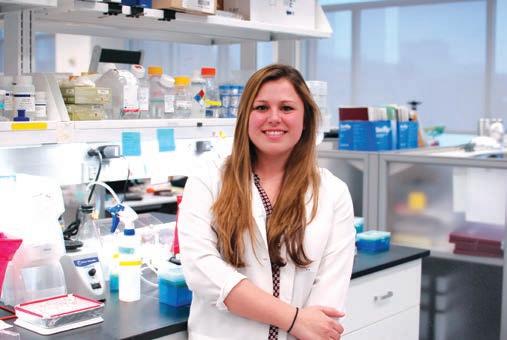 By Katherine Unger Baillie
By Katherine Unger Baillie
Megan Clark, a third-year student at Penn Vet, was selected as a Medical Research Fellow by the Howard Hughes Medical Institute (HHMI). She is among 66 medical and veterinary students chosen to spend a year in a laboratory working with a mentor on a biomedical research project that the student proposed. Each medical fellow receives $41,000 in grant support from HHMI, and fellows are eligible to apply for a second year in the program. The program allows participants a respite from their medicine or veterinary training to burnish their research skills, with an aim to produce physicians and veterinarians well versed in basic scientific research.
Clark first gained research experience as an undergraduate at the University of Delaware, where she completed a thesis focused on characterizing the immune cells present in the adipose tissue of dairy cows. She has continued to pursue immunology research while at Penn Vet, working in the lab of Phillip Scott, PhD, Professor of Microbiology and Immunology in the Department of Pathobiology. There, she has examined the role of T cell metabolism during infection with the parasite Leishmania, which causes a serious skin disease common in the tropics called leishmaniasis.
Recently, the Scott lab found that tissue-resident memory T cells are present not only at the site of Leishmania infection, but also at skin sites distant to infection, where these cells can be retained for as long as a year and play a role in protective immunity against the disease. During the fellowship, Clark will build on these findings, using a murine model to examine how these T cells migrate into noninflamed skin sites and how they are retained in the skin to provide protection against leishmaniasis.
WWW.VET.UPENN.EDU/BELLWETHER 31 CAMPUS UPDATES
MEGAN CLARK
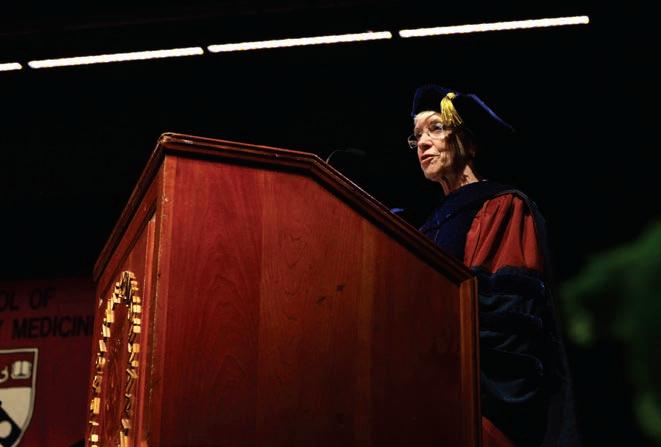


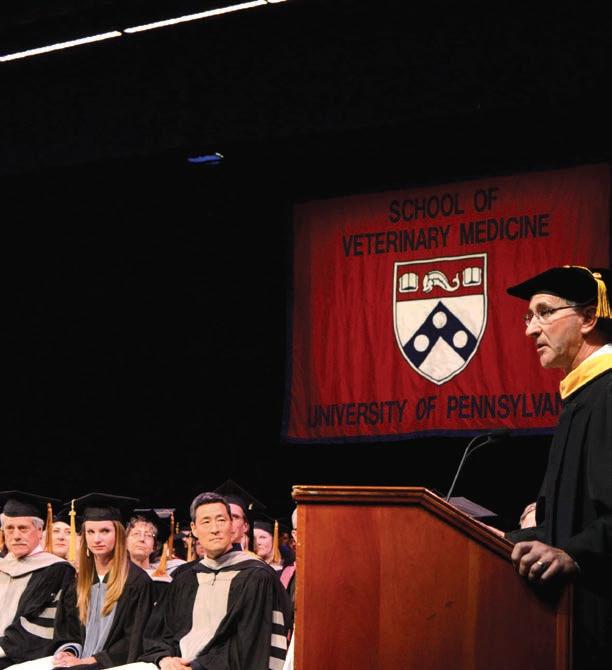
32 BELLWETHER FALL 2016 CAMPUS UPDATES
GRADUATION 2016
The Class of 2016 graduates! (At left) Class president Kathleen Stevens holds the class flag, presented by Dr. Harry W. Werner, V’74. (Bottom left) Dean Joan Hendricks greets the assembled family and friends of the graduates. (Bottom right) The commencement address was delivered by Russell C. Redding, Pennsylvania Department of Agriculture Secretary.
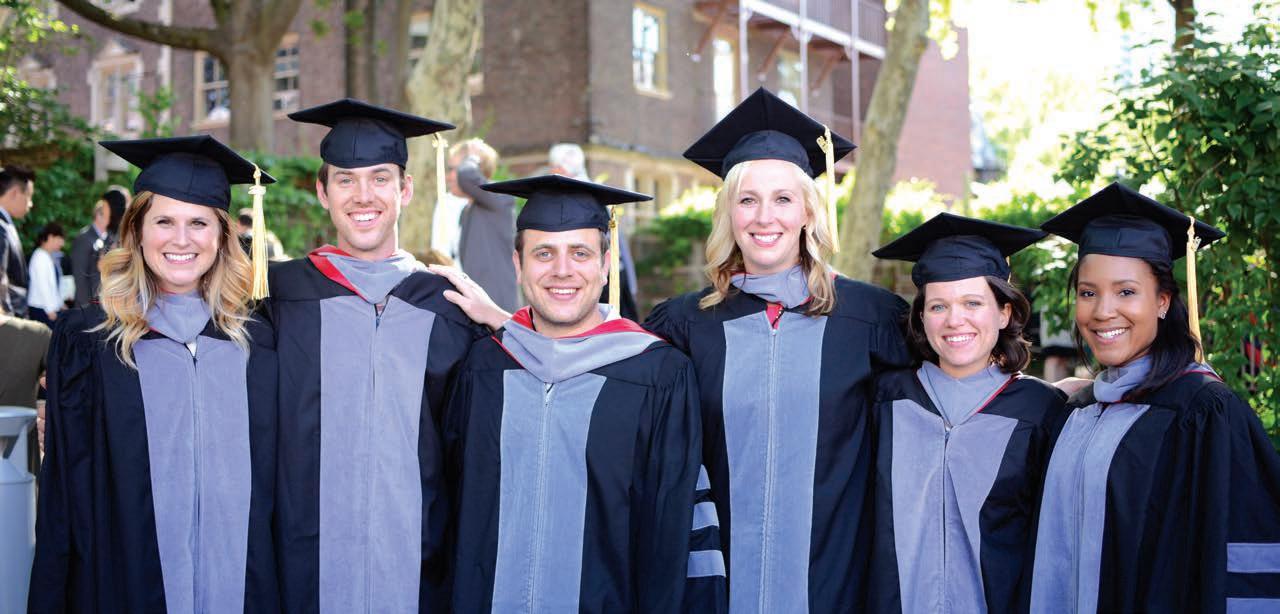
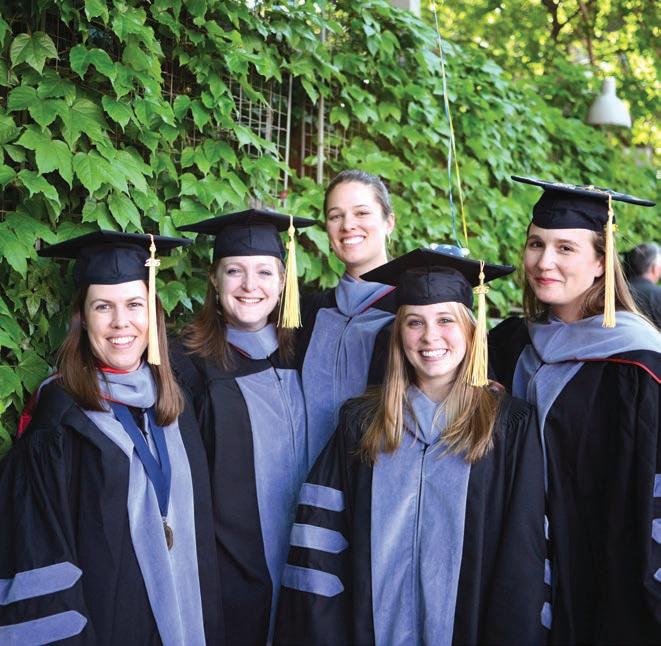


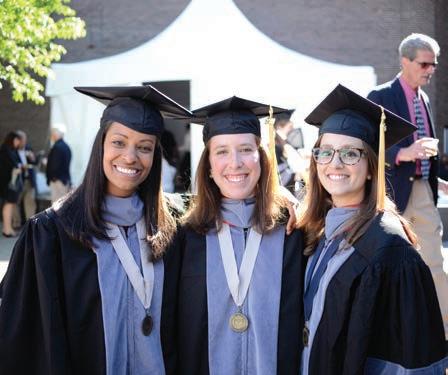


WWW.VET.UPENN.EDU/BELLWETHER 33 CAMPUS UPDATES
Penn Vet’s Dr. Lesley King, Pioneer in Veterinary Critical Care, Dies at Age 51
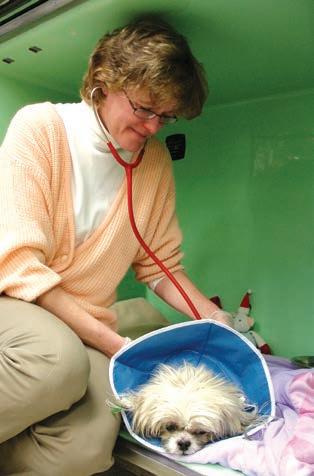
Lesley Geraldine King, MVB, originally from Dublin, Ireland, and a resident of Coatesville, Pennsylvania, died May 14, 2016, at the age of 51, after a long illness.
Dr. King, Professor of Critical Care, was a founder and pillar of critical care at Penn Vet and beyond. She was instrumental in the development of the veterinary intensive care specialty, particularly in expanding and refining mechanical ventilation.
A 1986 graduate of the University College Dublin School of Veterinary Medicine, Dr. King spent her entire career at Penn Vet, where she was responsible for training numerous emergency and critical care residents, interns, and technicians. She held leadership positions as Director of the Intensive Care Unit at Penn Vet’s Ryan Hospital and as President of the American College of Veterinary Emergency and Critical Care. A founding Diplomate of the European College of Veterinary Internal Medicine-Companion Animals, she also served as a Diplomate of the American College of Veterinary Internal Medicine and the American College of Veterinary Emergency and Critical Care.
Dr. King’s contributions to the University and to the field were recognized with the 2012 Christian R. and Mary F. Lindback Award for Distinguished Teaching from the University of Pennsylvania; the 2013 Jack Mara Scientific Achievement Award from the American College of Veterinary Emergency and Critical Care; and the 2013 Ira M. Zaslow Distinguished Service Award from the Veterinary Emergency and Critical Care Society.
A sought-after international speaker, Dr. King left lasting contributions on the treatment and diagnosis of challenging and life-threatening conditions in cats and dogs. Her research focused on respiratory failure, pulmonary medicine, applications of positive pressure ventilation in small animals, and outcome prediction in the critical small animal patient. Along with nearly 50 scientific research publications, she edited the authoritative Textbook of Respiratory Disease in Dogs and Cats, which was translated into Japanese and Spanish, and the British Small Animal Veterinary
Association’s Manual of Canine and Feline Emergency and Critical Care, now in its second edition.
“Lesley was distinguished, accomplished, and passionate. She had high standards and clear thinking, and was an unmatched administrator,” said Penn Vet Dean Joan Hendricks. “Penn Vet’s Intensive Care Unit and the critical care specialty are in the hands of her professional children. We all mourn her loss, but are consoled by her lasting accomplishments and contributions.”
Dr. King was in the presence of her closest family and friends during her last days. She was loyal, pure in her focus, and wholly devoted to her friends, patients, students, and ICU. In the management of her illness and the grief of her loved ones, she was brave, gracious, dignified, kind, and open. In full accordance with who she was, she has taken care of those she loved, including her pet chickens, horses, dogs, and cats. She is survived by her mother, Violet, and siblings Caroline, Suzanne, and Richard.
In lieu of flowers, contributions can be made in Dr. King’s memory for student scholarship at Penn Vet. Please make checks payable to the “Trustees of the University of Pennsylvania” and mail to the Penn Vet Development Office at 3800 Spruce Street, Suite 172E, Philadelphia, PA 19104.
34 BELLWETHER FALL 2016 CAMPUS UPDATES
“Lesley was distinguished, accomplished, and passionate. She had high standards and clear thinking, and was an unmatched administrator.”
Penn Vet Dean Joan Hendricks
Penn Vet Announces Winners of 2016 Student Inspiration Awards
Projects highlight an ongoing tradition of innovation
By John Donges
Jane Karpowicz, Ellen Lapuck, and W. Wendy Kuo, all V’18, received Penn Vet’s prestigious Student Inspiration Awards for 2016. Launched in 2008, the award is presented annually to Penn Vet students who demonstrate the potential to significantly advance the frontiers of veterinary medicine and expand the profession’s impact on the well-being of animals and society.
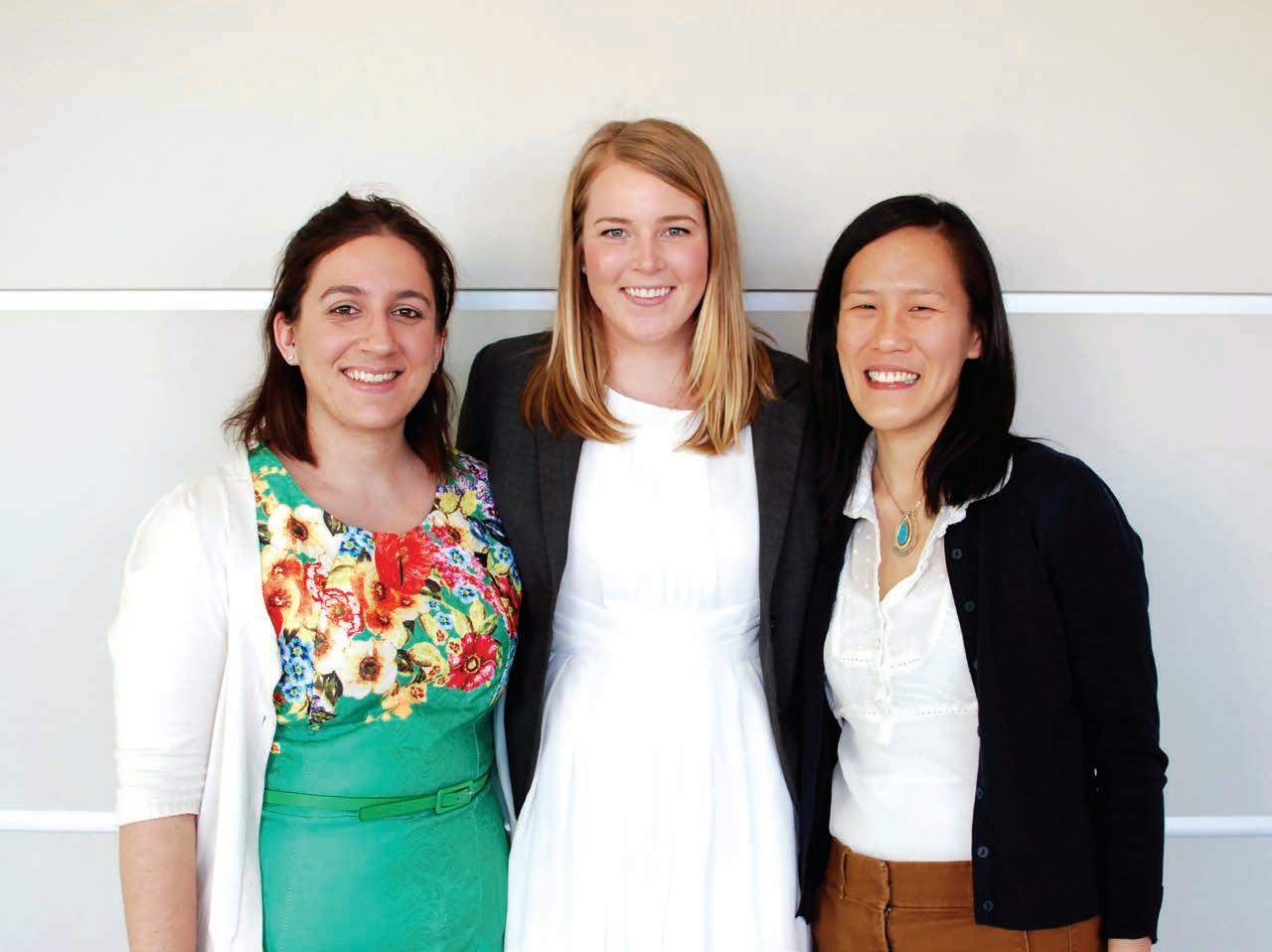
“Penn Vet students constantly impress me throughout the year, but always during the Inspiration Award presentations,” said Penn Vet Dean Joan Hendricks. “Our 2016 winners carry on a tradition of excellence for the benefit of society and the veterinary profession. I’m especially delighted that this year’s projects embody the One Health concept to improve the health of humans, animals, and the environment.”
Karpowicz, a second-year student and native of Chester Springs, Pennsylvania, and Lapuck, a second-year student and native of Sharon, Massachusetts, received $25,000 for their winning proposal, “A Focus on Poultry: Reducing Morbidity and Mortality for Smallholder Farmers in Uganda.” The funds will be used to develop a program in Uganda to train poultry farmers and implement a vaccine campaign against the Newcastle Disease virus. Of the 98 percent of
WWW.VET.UPENN.EDU/BELLWETHER 35 CAMPUS UPDATES
(From left) Ellen Lapuck, Jane Karpowicz, and W. Wendy Kuo, all V’18
indigenous chickens that are affected by disease annually, Newcastle Disease accounts for 72 percent of these diseases.
As free-range poultry increases in number each year, it is vital for farmers to maintain this important source of income and protein. The program will provide farmers with training and resources on basic poultry husbandry. Additionally, Karpowicz and Lapuck will work with Veterinarians Without Borders – U.S. to administer Newcastle Disease vaccines to participants’ flocks and identify a vaccine coordinator for each village. A model chicken coop will be constructed, underscoring the importance of protecting flocks from predators, theft, and disease.
“We’re looking forward to working together with poultry farmers in Uganda to address poultry management systems and to decrease prevalence of disease,” said Karpowicz. “Our ultimate goal is to help farmers maintain both economic and nutritional well-being for themselves and their families through increased poultry production.”
“Jane and I are thrilled and honored to receive this award for our international project,” said Lapuck. “We are very excited about the potential of this program to inspire Penn Vet students to become leaders and ambassadors in world health, as well as the One Health initiative.”
Kuo, a second-year student and native of Alexandria, Virginia, received $25,000 for her winning proposal, “Little Biota, Big Data.” The funds will be used to compile microbiome data representative of a healthy baseline for different food animal species. Based on the compiled data, visualization and analysis tools will be developed, and the data and analysis will be incorporated into a central repository.
“In any species, antibiotic use wipes out bad and good microbial populations and contributes to the development of antibiotic-resistant strains,” said Kuo. “Yet, the use of antibiotics at sub-therapeutic levels in food animals has been shown to enhance growth. Understanding the mechanisms of growth promotion and acquisition of resistance would be invaluable in protecting food sources from disease while also ensuring that rising global populations are adequately fed.”
Ultimately, this project aims to rapidly detect emerging antibiotic-resistant microbes by recognizing patterns in changing communities of the microbiome of food animals.
Previous Student Inspiration Award winners have used the prize money to develop a commercial aquaponics system at W.B. Saul High School of Agricultural Sciences in Philadelphia; create a Dairy Education Center in Thailand to empower women farmers; spark veterinary entrepreneurship through an innovation challenge; and inform the public and policymakers about wildlife trade using Google Earth, to illustrate unreported issues and their devastating impact on wildlife, humans, and ecosystems.
36 BELLWETHER FALL 2016
“We are very excited about the potential of this program to inspire Penn Vet students to become leaders and ambassadors in world health, as well as the One Health initiative.”
Ellen Lapuck, V’18
PENN VET WINS SAVMA BID FOR 2018 ANNUAL CONVENTION
BY ASHLEY BERKE
For the first time in the 46-year history of the Student American Veterinary Medical Association (SAVMA) annual convention, Penn Vet has won the bid to host the storied event in 2018.
But the bid presentation almost didn’t happen.
A MISSED CONNECTION
Colleen Barrett, V’18, Penn Vet’s senior SAVMA delegate, had just completed a clinical pathology midterm in mid-March. She and three fellow students immediately headed to the Philadelphia airport to catch their flight to the 2016 SAVMA Symposium in Ames, Iowa. Upon arrival at PHL, they were met with the unfortunate news that their flight was delayed two hours.

“We had a layover at Chicago O’Hare, so we were concerned we’d miss our connecting flight,” said Barrett.
A sense of momentary relief when the plane finally headed for the tarmac was short-lived. “Just when we thought we were about to take off, the pilot announced that we had to head back to the gate,” Barrett recalled.
By the time they finally took flight and landed in Chicago, the group had missed their connection by 10 minutes.
They were stranded.
“We considered renting a car and driving the five hours through the night to Iowa,” Barrett said. Instead, the students devised a plan and divided responsibilities. “It was a great teambuilding exercise,” she added.
Despite feeling like they were “never going to make it,” the group found hotel rooms in Chicago and a flight out the next morning.
WWW.VET.UPENN.EDU/BELLWETHER 37
Colleen Barrett, V’18
Because of the delay, Barrett was unable to attend the house of delegates meeting in Iowa, during which students nominate their schools for bid presentations. Students from the University of Georgia College of Veterinary Medicine placed a nomination for their bid.
Thankfully, Barrett was in touch with a friend who was present at the meeting and willing to nominate Penn Vet. Barrett accepted the nomination by phone.
“We were official,” she said with relief.
INTENSE PREPARATION
Penn Vet’s bid presentation was over two years in the making. Last year’s senior SAVMA delegate, Meghana Pendurthi, V’17, led the tremendous effort for the school’s first bid. Despite the fantastic presentation, Penn Vet lost to Texas A&M’s College of Veterinary Medicine and Biomedical Sciences.
“We are very excited for them and can’t wait to visit College Station next year,” said Barrett.
Last year’s presentation provided the perfect foundation for the team’s bid this year. “There was so much hard work put into it,” said Barrett. “We decided to take what we learned from the experience and go for it again.”
Among the lessons learned: have fun!
Barrett and junior delegate Steve Hanes, V’19, launched into the preparations with gusto, forming a planning committee, reaching out to hotels, brainstorming wet labs and lectures, and more.
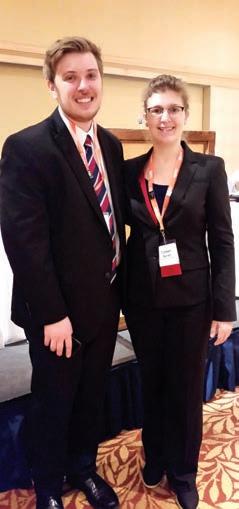
The first step was to submit a bid package, which Barrett says was heavily influenced by Pendurthi’s fine work.
Next, she and Hanes collaborated on the presentation. Taking to heart the advice to have fun, they opted to use Prezi, a visual storytelling tool, rather than PowerPoint, in order to have more freedom with the narrative. It paid off.
A WINNING PRESENTATION
It took 24 hours, but the Penn Vet team finally arrived in Ames. After mingling with their fellow delegates, they went back to work, putting the final touches on their presentation. The bid was the next day.
Georgia presented first. Barrett and Hanes waited anxiously in the audience until it was their turn.
“We had rehearsed so much, and we were so in sync,” said Barrett. “Everything went smoothly, and the audience seemed engaged.” But the results wouldn’t come for another three hours.
After the 100-plus delegates in attendance cast their votes, the results were in. Penn Vet would host the 2018 convention.
According to Barrett, attendees seemed most excited about Penn Vet’s rich history and new innovations.
“They were impressed by the robotics-controlled imaging system at New Bolton Center and our facilities, caseloads, and specialties,” she said. “They were also excited to visit Philadelphia.”
Barrett and Hanes made it a point to highlight Penn Vet’s unique standing as the country’s only urban veterinary school. “As an urban school, we have a unique perspective,” said Barrett. “We get to help our community in a really distinctive way.”
Back at Penn Vet, everyone was ecstatic to hear the news. “We got a wonderful reception when we returned,” Barrett noted.
“I could not be more pleased, proud, and excited that our wonderful student leaders put together a winning bid to host the national SAVMA convention,” said Penn Vet Dean Joan
38 BELLWETHER FALL 2016
Barrett and Steve Hanes, V’19, were photographed after winning the bid at the 2016 SAVMA Symposium in Ames, Iowa.
SAVMA Symposium: Get the Scoop and Get Involved March 15-17, 2018
For more information about the SAVMA Symposium 2018, what we have planned at Penn Vet, and how you can help, visit www.pennvetsavma.wix.com/pennvetsavmasymp2018
To view Penn Vet’s winning presentation, visit www.bit.ly/1RWAwLh.
Hendricks. “We look forward to showing off our programs and campuses, as well as the historic city and beautiful farmlands that surround us.”
“Through very coordinated and purposeful efforts, our student leaders figured out what they needed to ensure success for this year’s bid,” said Dr. Mary Bryant, Executive Director of the Office for Students. “Through their sheer grit and determination, they succeeded. To me, the best part of this story is how they coordinated with last year’s leaders, learned from any mistakes made, and together made it all happen. I am immensely proud of them.”
IN THE SPOTLIGHT
From March 15 to 17, 2018, more than 1,000 veterinary school representatives will descend on Philadelphia as Penn Vet hosts the SAVMA annual convention.
Delegates from the American Veterinary Medical Association (AVMA), Student Chapter of the American Veterinary Medical Association (SCAVMA), and SAVMA will participate in official meetings throughout the three-day event. Veterinary students will have the opportunity to hear lectures, take tours, and participate in wet labs. Lecture topics may range from equine orthopedic therapy and herd breeding management to canine cancer immunotherapy and the role of veterinary medicine in One Health.
Barrett is confident that Penn Vet will shine. “From the Minimally Invasive Surgery Suite to our emergency services to the robots at New Bolton Center, Penn Vet will be in the spotlight,” she said.
And, of course, there will be plenty of opportunities for attendees to explore Philadelphia, which was named the number one U.S. travel destination for 2016 by Lonely Planet and recently designated the nation’s first World Heritage City. Plans are still in the works, but outings will include tours of historic Philadelphia and the region’s renowned breweries, as well as hikes through Fairmount Park and a visit to the famed Reading Terminal Market.
Barrett hopes that attendees will leave with a new appreciation of all that makes Penn Vet unique. “I hope people realize how incredible an urban vet school can be, and that we’ve been here for well over 100 years and we continue to lead the way,” she said.
Four student chairs—including a fundraiser, treasurer, and two co-managers—are hard at work pulling together all of the convention plans. Despite passing on the torch, Barrett will remain involved.
“I’m looking forward to seeing it all come to fruition in my final year of vet school,” Barrett said. She has plenty of reasons to be proud. “We tried before. We came back even stronger. We won. Now we’re incredibly excited to show it all off.”
WWW.VET.UPENN.EDU/BELLWETHER 39
VMDs Who Lead in Zoo, Wildlife, and Exotic Medicine
 BY KRISTEN MCMULLEN
BY KRISTEN MCMULLEN
40 BELLWETHER FALL 2016
Imagine getting a call that an entire species is about to be wiped out, and you are the one to help save it. Well, that is exactly what happened to Charles Innis, V’94, an expert on turtle medicine and conservation, when he received a call from a Palawan turtle expert in the Philippines. During a warehouse raid, government officials had found 3,800 Palawan turtles stacked high, one upon the other. They were intended to become turtle soup.
Experts had thought the entire species numbered less than 3,800, so saving as many of the turtles as possible was vital to the survival of the species. Director of Animal Health at the New England Aquarium since 2005, Dr. Innis and three other veterinarians from around the world with turtle expertise quickly traveled to the Philippines, where they triaged and treated more than 1,000 turtles.
How many people can say that they safely removed a tiger from an apartment in Harlem, New York City? Robert Cook, V’80, can. His resume also includes providing health care for 35 hand-raised baby gorillas and being part of the first successful aquarium beluga whale births, when he served as the Chief Veterinarian for 1,300 species in the Wildlife Conservation Society zoological parks.
Then there is the late James Wright, V’51, whose distinguished career included working as a veterinarian at the National Zoo in Washington, D.C.; serving as a commissioned officer in the U.S. Public Health Service; and participating in projects for the Air Force—first at the Primate Laboratory in Texas and, later, at the Yerkes National Primate Research Center in Atlanta, where he worked with the U.S. Environmental Protection Agency as section chief and pathologist in the Health Effects Research Laboratory. He also served on the veterinary faculty of North Carolina State University as adjunct associate professor in the College of Veterinary Medicine.
After Dr. Wright’s passing, his son found papers regarding a trip he took to Senegal. The government was damming a river and seeking to save the area wildlife. Dr. Wright was called upon to help select the healthiest animals, determine how to immobilize them, and move them to their home in a newly established zoo. He helped refine the original dart gun and developed anesthetics in appropriate doses to be used as the tranquilizing agent.
Then there is Shirley Yeo Llizo, V’89, who you may recognize from her appearances on the pilot and an additional episode of Animal Planet’s Animal Cops: Houston. In one episode, she was subpoenaed as an expert witness in a confiscation case; in another, she assisted the state in transferring three circus brown bears to a wildlife sanctuary in east Texas. At the time, she worked at the Houston Zoo and assisted at the Houston SPCA when they had confiscations of wild and exotic animals. Prior to that, she served as the Head Veterinarian at the Singapore Zoo, having been recruited for that job just one year after graduation. She currently serves as the Veterinarian at the Topeka Zoo & Conservation Center.
Right up the street from Penn Vet at the Philadelphia Zoo, America’s first zoo, Tim Georoff, V’04, works as Associate Veterinarian. In addition to his regular duties at the Zoo, he serves as Co-Veterinary Advisor for the Association of Zoos and Aquariums’ Ring-
 Shirley Yeo Llizo, V’89, Zoo Veterinarian at the Topeka Zoo & Conservation Center
Shirley Yeo Llizo, V’89, Zoo Veterinarian at the Topeka Zoo & Conservation Center
WWW.VET.UPENN.EDU/BELLWETHER 41
Penn Vet alumni across generations have made and continue to make their mark in zoo, wildlife, and exotic animal medicine. And their work is nothing less than fascinating.
Tailed Lemur Species Survival Plan Program. He has also provided veterinary support for several in situ and ex situ conservation projects, most recently with Panthera—assisting with a snow leopard GPS collaring project in Kyrgyzstan.
Wilbur Amand, V’66, joined the staff of the Philadelphia Zoological Society in 1974 as its first staff veterinarian, later to become the Curator of Mammals, Vice President for Animal Health and Biological Programs, and an interim Acting Director of the Philadelphia Zoo. At the Zoo, Dr. Amand developed a number of courses in avian, reptile/amphibian, and zoo mammal medicine. He has made his mark on the profession, having also served as Editor of the Journal of Zoo and Wildlife Medicine and Executive Director of the American Association of Zoo Veterinarians, the Association of Reptilian and Amphibian Veterinarians, and the American Academy of Veterinary Nutrition.
Dr. Amand is currently a member of the Animal Policy Committee of the National Aquarium in Baltimore, Maryland, and serves on the Board of Directors of Elephant Care International. He retired from Penn Vet as an Adjunct Professor of zoological medicine. He continues to mentor and guest lecture in the fields of companion exotic animal medicine as well as zoo and wildlife medicine.
A little further up the road, Adam Denish, V’93, oversees veterinary care for the residents of the Elmwood Park Zoo in Norristown, Pennsylvania. I had the privilege of recently observing a “day in the life” of Dr. Denish at Elmwood Park Zoo, where in one day he treated a Chacoan peccary named George, giraffes Jukuu and Dhoruba, a black rat snake, Anzona the kingsnake, Meteetsee the ferret, and several other species. With expertise in exotic and zoo animal medicine, he also has a private practice where his clientele includes the occasional monkey among other animals.

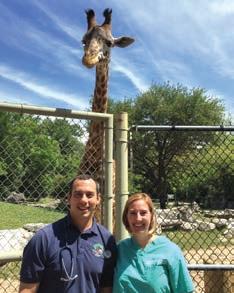
Howard Krum, V’92, helped launch both the Georgia Aquarium and the Georgia Sea Turtle Center. He was featured on the PBS TV series Scientific American Frontiers with Alan Alda, and his work with stranded sea turtles, large whales, and dolphins has been recognized on NBC Nightly News, various regional news stations, and in dozens of newspaper outlets including The Boston Globe. In addition, Dr. Krum’s contributions to help create the world’s largest aquarium were chronicled in the award-winning documentary Window to Wow/The Opening of the Georgia Aquarium, produced by WXIA-TV Atlanta.
After graduation, Dr. Krum’s classmate Roy Yanong, V’92, was hired by 5-D Tropical, Inc., a large ornamental fish farm in Plant City, Florida, where he plunged into the aquarium fish industry. In 1996, he joined the University of Florida (UF)/Institute of Food and Agricultural Sciences Tropical Aquaculture Laboratory in Ruskin, Florida, where he works today—providing extension, research, and educational programs in fish health management, including on-site veterinary assistance and disease diagnostic support for aquaculturists throughout the state. He also works closely with the Florida Fish and Wildlife Conservation Commission and Florida’s Department of Agriculture and Consumer Services. Roy is currently an associate professor and extension veterinarian in the Fisheries and Aquatic Sciences Program of the School of Forest Resources and Conservation, headquartered on UF’s main campus in Gainesville, Florida. He is a faculty member in the UF College of Veterinary Medicine’s Aquatic Animal Health Program.
Penn Vet alumni also do a great job of coming together to solve problems. When James Kusmierczyk, V’10, noticed a focal mass associated with the right eye of a female gerenuk at the Cameron Park Zoo in Waco, Texas, he invited the Ophthalmology Service and Zoo,
James Kusmierczyk, V’10, collaborated with Erin Scott, V’10, Clinical Assistant Professor of Ophthalmology at Texas A&M University, on a case involving a female gerenuk at the Cameron Park Zoo in Waco, Texas.
42 BELLWETHER FALL 2016
MORE STORIES WANTED!
Are you a VMD working in the zoo, wildlife, or exotics field? Contact us with a photo and short bio to be profiled on the Penn Vet website in part two of our continuing coverage. Email the alumni office at kmcmul@vet.upenn.edu
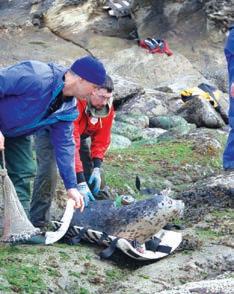
Exotics, and Wildlife Service from the College of Veterinary Medicine & Biomedical Sciences at Texas A&M University to assist with a sedated ophthalmic examination. Erin Scott, V’10, Clinical Assistant Professor of Ophthalmology at Texas A&M University, was able to determine that the mass was not a tumor as initially suspected, but a staphyloma. Staphylomas are focal regions of abnormally thinned sclera, the outer fibrous layer of the eye, that are lined by uveal tissue. They can appear as a tan, gray, or blue mass covered by conjunctiva. In the gerenuk’s case, this likely occurred secondary to an unknown trauma and, luckily, treatment was not necessary.
Definitely not everyday medicine for most veterinarians, Anne Staudenmaier, V’15, has done a wellness exam on a kinkajou, assisted delivery of chinchilla kits, amputated a tail on a ferret, and removed a snake stuck in concrete tubing. Dr. Staudenmaier is pursuing her passion in exotics with an internship and residency at Angell Animal Medical Center in Boston—and she said that she is loving every moment of it. She will be doing her residency to become boarded in avian medicine, along with an alternative track for exotic companion mammal and zoo medicine.
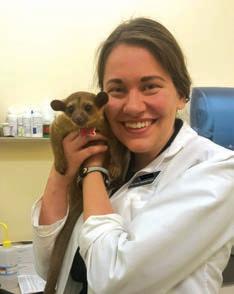
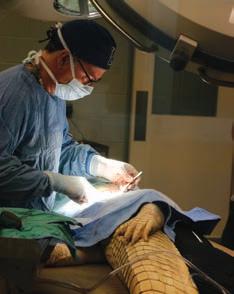
While studying biology at Harvard University, Christopher Bonar, V’91, assisted with field research on black rhinos in Kenya and the biomechanics of air breathing in lungfish. His post-doctoral internship was in wildlife medicine at the Wildlife Center of Virginia. Subsequently, he served as Zoo Veterinarian for the Fort Wayne Children’s Zoo in Fort Wayne, Indiana, and then as Associate Zoo Veterinarian for the Cleveland Metroparks Zoo in Cleveland, Ohio. He then moved to Dallas to be Chief Veterinarian for the Dallas World Aquarium, until moving to the Dallas Zoo in January 2013. He noted, “I actually went to Penn for veterinary school specifically to get into the zoo and wildlife medicine business, and it has led to a great career. I absolutely love what I do!”
Joe Gaydos, V’94, is a Senior Wildlife Veterinarian and the Chief Scientist for the SeaDoc Society, a science-based marine conservation program of the UC Davis Karen C. Drayer Wildlife Health Center. Also holding a PhD from the University of Georgia, he is a selfproclaimed “science nerd” with a passion for all things wild.
For over a decade, Dr. Gaydos has been working on wildlife and ecosystem health issues in the Pacific Northwest. He currently serves on Washington State’s Wildlife Diversity Advisory Council and co-authored a bestselling book, The Salish Sea: Jewel of the Pacific Northwest (2015, Sasquatch Books). As a wildlife veterinarian, Dr. Gaydos works to address diseases in wildlife at the individual animal level such as chemical immobilization of wildlife, surgically implanting satellite transmitters, and providing veterinary oversight for harbor seal rehabilitation. At the
(Top) Anne Staudenmaier, V’15; (middle) Christopher Bonar, V’91; (bottom) Joe Gaydos, V’94.
WWW.VET.UPENN.EDU/BELLWETHER 43
population level, he helps determine which diseases pose a risk to endangered killer whales. And as a translational scientist, he works to connect people to the amazing resources of the Salish Sea.
Paul Calle, V’83, joined the Wildlife Conservation Society (WCS) in 1989. As Chief Veterinarian and Director of the Zoological Health Program based at the Bronx Zoo, he oversees the Clinical, Pathology, and Aquatic Animal Medicine and Pathology Departments for WCS’s Zoos and Aquarium. He also chairs the WCS Institutional Animal Care and Use Committee (IACUC). During his tenure as Chief Veterinarian, a Molecular Diagnostics Laboratory has been created; health contributions to local conservation efforts have expanded; and participation in international wildlife health projects has increased, including those focused on a variety of turtle species and Caribbean ground iguanas. In support of WCS’s global conservation efforts, Dr. Calle has traveled to Asia, Russia, Latin America, and the Caribbean.
Donald Neiffer, V’92, Chief Veterinarian of the Smithsonian’s National Zoo in Washington, D.C., oversees the health care of the National Zoo’s entire animal collection of around 1,800 animals representing 300 different species. He also leads and conducts clinical and conservation research and training programs within the Zoo’s Department of Animal Health. Dr. Neiffer previously served as the Director of Conservation Medicine at The Wilds, an affiliate of the Columbus Zoo and Aquarium. He also spent 16 years as Veterinary Operations Manager for Walt Disney World’s Animal Programs, where he implemented preventative health-care programs, oversaw collaborative and independent research, and managed medical cases.
Gregory Lewbart, V’88, Professor of Aquatic, Wildlife, and Zoologic Medicine at North Carolina State University College of Veterinary Medicine, is a member of the Exotic Animal Medicine Service team and sees patients through this service in the NC State veterinary hospital and in the field. Dr. Lewbart founded the NC State CVM Turtle Rescue Team, and he is currently engaged in a multi-year field initiative in the Galápagos Islands—where he has productive collaborations with colleagues from the Universidad San Francisco de Quito, the Galápagos Science Center, the University of North Carolina, and the Galápagos National Park. He also serves as an Associate Editor for the Journal of Zoo and Wildlife Medicine and is a past President of the International Association for Aquatic Animal Medicine.
As a veterinarian, Jessica Dimuzio, V’78, specialized in wildlife preservation and had the opportunity to study wild baboons in Kenya, Africa. Soon after her studies ended, the land was sold to a cooperative of small farmers who regarded baboons as pests. The only way to save the baboons was to relocate them to a remote area of the country. The realization that land preservation was as vital as species studies led her, with her husband, Dr. Tim Halverson, to design holistic conservation education programs incorporating animal studies, land use, culture, and economics. They conducted these conservation programs for college students and wildlife biologists in the United States, Africa, and Asia.
But it wasn’t enough. To create a lasting conservation impact, Dr. Dimuzio wanted to reach youngsters, inspiring them to connect with the natural world and revel in its mysteries. The enthusiasm of students in naturalist programs she leads in the U.S. and abroad has encouraged her to engage even more children by relating true stories from her work, through writing and speaking engagements.
The innovation and influence of VMDs in zoo, wildlife, and exotic medicine is far-reaching. We look forward to seeing how alumni continue to serve animals and ecosystems—and improve the world—through their veterinary skills and knowledge.
44 BELLWETHER FALL 2016
Senior Class Gift Becomes Tradition
By Kristen McMullen
When the Classes of 2015 and 2016 neared their graduation milestone, they came together to leave their legacy at Penn Vet through a Senior Class Gift. The class officers knew that this was a great opportunity for their classmates to make an impact for the good of the School.
The Class Gift program is a student-led initiative that promotes a philanthropic spirit among the graduating classes, providing students an opportunity to give back to their alma mater.
Both classes let their classmates lead the process by conducting a vote on their gift designation.
The 2015 Senior Class Gift raised funds to purchase comfortable red and blue executive chairs for the student area on the third floor of Ryan Hospital. The area now has a more professional look for all who utilize the space.
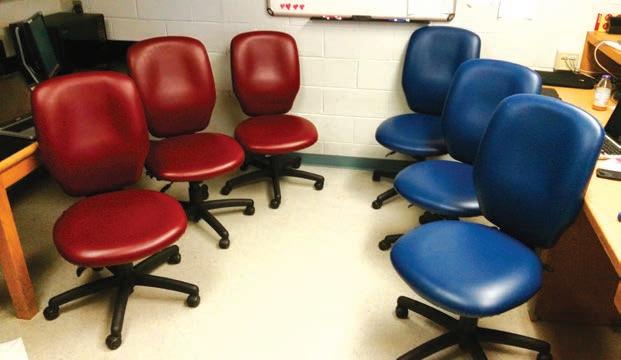
The 2016 Senior Class Gift raised funds for the Charitable Care Fund and the Shelter Medicine Fund to support the Pets for Life initiative. The Charitable Care Fund assists families of companion animals who cannot afford the full cost of veterinary services at Penn Vet. Penn Vet’s Shelter Medicine program teams up with the Humane Society of the United States and their Pets for Life program to provide free spay/neuter and wellness care for pets in underserved communities.
A heartfelt thank you to V’15 and V’16 for making their mark on Penn Vet and the community through their generous class gifts!
VMD Finder
The VMD Finder has received over 1,600 hits! Are you part of it? Sign up today at www.vet.upenn.edu/vmd-finder-form
The VMD Finder links potential clients with your practice. Check it out at www.vet.upenn.edu/vmd-finder
WWW.VET.UPENN.EDU/BELLWETHER 45 ALUMNI NEWS
1960s
Air Animal Pet Movers, owned by Walter Woolf, V’60, was recently featured in Lufthansa Cargo’s magazine, Planet Over the past 38-plus years, the company has relocated more than 45,000 dogs, cats, birds, fish, and other animals around the globe.
Barry Kellogg, V’66, was featured in an article in the Humane Society Veterinary Medical Association newsletter. He shared the story of what happened when he and his wife, Sally, decided to undertake an outreach effort to the migrant farmworker community in Florida. After Hurricane Wilma struck Florida in 2005—and after his previous deployment to Hurricane Katrina that same year—he knew they had to do something to help. They dispersed supplies and then, in 2016, undertook a basic veterinary care project in a Mexican migrant farmworker community. Following up on the success of the program, they look forward to visiting again in 2017. Read more about their story in the May 20, 2016, issue of the Humane Society Veterinary Medical Association newsletter.
1970s
K. Ann Jeglum, V’77, Oncology-Adjunct Associate Professor at The Wistar Institute, received the 2015 Veterinarian of the Year - AKC Canine Health Foundation Special Industry Award, presented at the 61st Annual Purina Pro Plan Show Dogs of the Year Awards event on February 13, 2016, in New York City. Dr. Jeglum launched Veterinary Oncology Services in West Chester, Pennsylvania, in 1990. In 1996, Veterinary Oncology Services and Research Center (VOSRC) opened its doors as the only designated private veterinary cancer center in the region. In 2001, VOSRC expanded with the opening of the Veterinary Oncology Services Radiation Center in Chalfont, Pennsylvania. Dr. Jeglum’s research continued with the development of Canine Lymphoma Monoclonal Antibody 231, which was commercialized in the 1990s. She and Dr. Zenon Steplewski hold a U.S. patent for monoclonal antibodies against canine lymphoma-associated antigens. She is currently a member of the Steering Committee for the Morris Animal Foundation’s Canine Lifetime Health Project, a prospective, lifetime cohort study designed to determine the incidence of cancer in golden retrievers and to identify genetic, nutritional, lifestyle, and environmental risk factors.
1980s
In June, Ellen Behrend, V’88, PhD, became the president of the American College of Veterinary Internal Medicine (ACVIM), the largest veterinary specialty organization in the world. She was also reappointed as the Joezy Griffin Chair in small animal internal medicine at the Auburn University College of Veterinary Medicine for a five-year renewable appointment. In 2014, she was named an Alumni Professor for Auburn University. Annually, Auburn recognizes five faculty members for research, publishing, and teaching by awarding five-year, non-renewable professorships through the Auburn Alumni Association.
Mount Tam Biotechnologies announced that Richard Marshak, C’81, V’88, has assumed the role of CEO. Dr. Marshak brings 18 years of pharmaceutical experience across a wide range of leadership roles. As Founder of LF Consulting, Head of Corporate Development at Health Systems Reform, and a former General Manager at Abbott/AbbVie, his work included strategic planning, strategic alliances, pharmaceutical sales, clinical development, product launch, and market access. After leaving AbbVie in 2013, Dr. Marshak provided consulting services to a wide range of development-stage life science companies. Formed on World Lupus Day 2014, Mount Tam Biotechnologies, Inc. was established to develop, optimize, and bring to market leading medical compounds to better the health and well-being of millions of people who have been affected by autoimmune diseases.
1990s
John Lewis, V’97, has been named editor-in-chief of the Journal of Veterinary Dentistry.
2000s
Nancy Soares, V’02, became president of the American Animal Hospital Association (AAHA) Board of Directors at its annual conference in April. In 2007, after working as an associate veterinarian for five years, Soares established her own practice—the Macungie Animal Hospital in Macungie, Pennsylvania—where she serves as owner and medical director. Her practice became AAHA accredited in 2008, won the AAHA-Accredited Practice of the Year Award in 2013, and has grown to include five full-time veterinarians.
ALUMNI NEWS 46 BELLWETHER FALL 2016
In Remembrance
John Quincy Adams, Jr., V’44, passed away on May 21, 2016, at Kings Daughters Community Health and Rehabilitation Center in Staunton, Virginia. He was 95 years old. He lived in Pennsylvania and practiced veterinary medicine until 1950. He then enlisted in the United States Army and remained on active duty until his retirement as a Colonel in July 1971. Upon his retirement, he relocated to Buchanan, Virginia, where he owned and operated a beef cattle farm, while continuing his veterinary practice.
Peter Bousum, V’69, passed away peacefully on March 26, 2016, with his family and Russell Terrier by his side. He was founding partner and President of the Mid-Atlantic Equine Medical Center in Ringoes, New Jersey. He was a pioneer and a visionary, who had foresight 30 years ago to see the need for an equine hospital in scenic Hunterdon County, New Jersey—a project that he decided to embark upon after years of traveling with the United States and Canadian Equestrian Teams. He served on the northeast regional Board of the American Association of Equine Practitioners; was Chairman of Veterinary Management III; lectured on lameness and prepurchase exam techniques both locally and nationally; and most recently specialized in nuclear scintigraphy. His patients included multiple Kentucky Derby, Hamiltonian, and Olympic champions. Doc Pete’s love of animals began with buying his first horse at age 12 for $25 and riding to the local hounds in ratcatcher garb, and later working his English Pointers in field trials.
Luis A. Colón Vargas, V’70, passed away on June 2, 2015. Dr. Colón was accepted to Penn Vet in 1966, after being introduced to veterinary medicine by Dr. Donald Lee during Dr. Lee’s visit to Puerto Rico in search of potential candidates for the veterinary school. After graduation, he spent a year in mixed animal practice in Pennsylvania before coming back to Puerto Rico in order to work in the Department of Agriculture, where he directed the Veterinary Division between 1978 and 1982. In 1985, after returning to private practice for three years, he began a residency in Equine Surgery at the College of Veterinary Medicine, and a year later a Master of Science program, both at The Ohio State University. Upon completion
of the residency and master’s degree programs, he stayed on as faculty in the ambulatory division until 1997. That year, he also became a Diplomate of the American Board of Veterinary Practitioners, certified in equine practice. He served on the Admissions Committee from 1994 to 1997. In the fall of 1997, he returned to Puerto Rico where he continued his equine practice while serving as director of the veterinary clinic at the Camarero racetrack; Special Assistant to the Director of Veterinary Services at the Puerto Rico Department of Agriculture; and clinician at the Caribbean Primate Research Center, part of the University of Puerto Rico Medical Sciences Campus. From 2000 to 2007 he was a member of the Puerto Rico Veterinary Medicine Examining Board, over which he presided between 2003 and 2007. Luis was driven by the pursuit of excellence in the practice of veterinary medicine, and by the possibility that it presents to alleviate suffering and promote well-being. His friends, colleagues, and students will sorely miss his energy, passion, and sense of humor.
After a long struggle with myelofibrosis, Geoffrey Goldworm, V’75, of Jupiter, Florida, died on April 17, 2016, with his family by his side. Dr. Goldworm was born in Manhattan; grew up in Easton, Pennsylvania; raised his family in Cherry Hill, New Jersey; and retired to Jupiter. He ran the first and largest emergency veterinary medical service in South Jersey. He was beloved by his patients and respected by his peers. The only thing that Geoff loved more than helping animals (and perhaps golf) was his beloved wife and kids. Nothing mattered more to him than family.
Kathleen Waldeck, V’76, passed away on January 17, 2016, due to sudden unexpected natural causes. She started a business in the small town of Mohnton, Pennsylvania, over 39 years ago. She not only built a business but also a home, and many clients quickly became her friends and family—both two- and four-legged. Throughout the years, she specialized in small animal medicine and also large animal medicine, and eventually developed a deeper passion for holistic care— which included, but was not limited to, chiropractic and herbal medicine. She took care of her clients in her hospital and also made house calls to homes and farms throughout the community and beyond.
SEND US YOUR NEWS!
Calling all VMDs and former Penn Vet interns and residents! Have you received a promotion, been married, had a baby, received an award, had a research finding, or opened a new business? Please share your good news with us! Visit the Alumni page of the Penn Vet website, email your news to the alumni office at kmcmul@vet.upenn.edu, or write to us at Alumni Relations, Penn Veterinary Alumni Office, 3800 Spruce Street, Suite 172E, Philadelphia, PA 19104.
WWW.VET.UPENN.EDU/BELLWETHER 47 ALUMNI NEWS
3800 Spruce Street
Philadelphia, PA 19104-6008
United Way of Greater Phila. & So. NJ: #50178
SEPTEMBER2016
September 20, 2016
Science After Hours:
Wizard School
Dr. Brittany Watson, Director of Shelter Medicine and Community Engagement, will participate to explore the incredible world of animals at Hogwarts.
7:00 PM to 10:00 PM
The Franklin Institute
222 North 20th Street
Philadelphia, PA 19103
To register, visit www. fi.edu/event/2016-09-20/ science-after-hours
September 26, 2016
Penn Annual Conference –Pre-Conference
Animals Behaving Badly –Veterinary/Welfare Perspectives
Sheraton Philadelphia
Downtown Hotel
201 North 17th Street
Philadelphia, PA 19103
September 27-28, 2016
Penn Annual Conference –Lectures
Sheraton Philadelphia
Downtown Hotel
201 North 17th Street
Philadelphia, PA 19103
September 29, 2016
Penn Annual Conference –Wet Labs
Penn Vet’s Ryan Hospital 3900 Spruce Street
Philadelphia, PA 19104
For conference details, visit www.vet.upenn.edu/PAC2016
OCTOBER2016
October 4, 2016
First Tuesday Lecture Series
A free educational lecture series for horse owners and horse enthusiasts. “Sports Medicine: Try Your Hand at Diagnosing Lameness”
Dr. Liz Arbittier and Dr. Jessica Morgan
6:30 PM to 7:30 PM
New Bolton Center – Alumni Hall
382 West Street Road
Kennett Square, PA
To register, call 610-925-6500
October 28-29, 2016
Parents & Partners Weekend
Penn Vet Philadelphia Campus and New Bolton Center
For info, contact Brittany Tinsley at bscan@vet.upenn.edu or 215-746-2421
NOVEMBER2016
November 1, 2016
First Tuesday Lecture Series
“3D Printing in Veterinary Medicine”
Dr. Kathryn Wulster
6:30 PM to 7:30 PM
New Bolton Center –Alumni Hall
382 West Street Road
Kennett Square, PA
To register, call 610-925-6500
November 2, 2016
Continuing Education Series
Presented by Dr. Leontine Benedicenti, Neurology
6:00 PM to 8:30 PM
Vernon and Shirley Hill Pavilion
380 S. University Ave.
Philadelphia, PA 19104
To register, call Megan Nelson at 877-PENN-VET
DECEMBER2016
December 5, 2016
Alumni Reception at AAEP Convention
Orlando’s Orange County Convention Center
9899 International Drive
Orlando, FL 32819
For info, contact Brittany Tinsley at bscan@vet.upenn.edu or 215-746-2421
December 6, 2016
First Tuesday Lecture Series
“Regenerative Medicine: Can We Help Our Horses Heal?”
Dr. Kyla Ortved
6:30 PM to 7:30 PM
New Bolton Center –Alumni Hall
382 West Street Road
Kennett Square, PA
To register, call 610-925-6500
December 8, 2016
Continuing Education Series
Presented by Dr. Anna Gelzer and Dr. Marc Kraus, Cardiology
6:00 PM to 8:30 PM
Vernon and Shirley Hill Pavilion
380 S. University Ave.
Philadelphia, PA 19104
To register, call Megan Nelson at 877-PENN-VET
FEBRUARY2017
February 5, 2017
Alumni Reception at NAVC Conference
7:00 PM to 9:00 PM
Orlando’s Orange County Convention Center
9899 International Drive
Orlando, FL 32819
For info, contact Brittany Tinsley at bscan@vet.upenn.edu or 215-746-2421
For more information about these events, contact Brittany Tinsley, Assistant Director of Institutional Events, at bscan@vet.upenn.edu or 215-746-2421.
Nonprofit Organization U.S. Postage PAID Philadelphia, PA Permit No. 2563
Penn Vet alumni and donors receive Bellwether magazine free of charge.
Penn Vet is proud to print Bellwether magazine on FSC® (Forest Stewardship Council™) certified paper, which supports the growth of responsible forest management worldwide through its international standards.
calendar
Penn Vet is proud to print Bellwether magazine on FSC® (Forest Stewardship Council™) certified paper, which supports the growth of responsible forest management worldwide through its international standards.

































































 By Katherine Unger Baillie
By Katherine Unger Baillie















 BY KRISTEN MCMULLEN
BY KRISTEN MCMULLEN
 Shirley Yeo Llizo, V’89, Zoo Veterinarian at the Topeka Zoo & Conservation Center
Shirley Yeo Llizo, V’89, Zoo Veterinarian at the Topeka Zoo & Conservation Center





